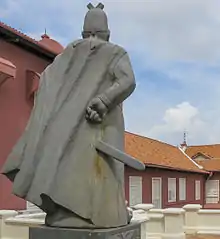History of Malaysia
Malaysia is located on a strategic sea-lane that exposes it to global trade and various cultures. Strictly, the name "Malaysia" is a modern concept, created in the second half of the 20th century. However, contemporary Malaysia regards the entire history of Malaya and Borneo, spanning thousands of years back to prehistoric times, as its own history, and as such, it is treated in this page.
Part of a series on the |
|---|
| History of Malaysia |
 |
|
|
An early western account of the area is seen in Ptolemy's book Geographia, which mentions a "Golden Khersonese," now identified as the Malay Peninsula.[1] Hinduism and Buddhism from India and China dominated early regional history, reaching their peak during the reign of the Sumatra-based Srivijaya civilisation, whose influence extended through Sumatra, Java, the Malay Peninsula and much of Borneo from the 7th to the 13th centuries.
Although Muslims had passed through the Malay Peninsula as early as the 10th century, it was not until the 14th century that Islam first firmly established itself. The adoption of Islam in the 14th century saw the rise of several sultanates, the most prominent were the Sultanate of Malacca and the Sultanate of Brunei. Islam had a profound influence on the Malay people but has also been influenced by them. The Portuguese were the first European colonial powers to establish themselves on the Malay Peninsula and Southeast Asia, capturing Malacca in 1511, followed by the Dutch in 1641. However, it was the English who, after initially establishing bases at Jesselton, Kuching, Penang and Singapore, ultimately secured their hegemony across the territory that is now Malaysia. The Anglo-Dutch Treaty of 1824 defined the boundaries between British Malaya and the Dutch East Indies (which became Indonesia). On the other hand, the Anglo-Siamese Treaty of 1909 defined the boundaries between British Malaya and Siam (which became Thailand). The fourth phase of foreign influence was an immigration of Chinese and Indian workers to meet the needs created by the colonial economy in the Malay Peninsula and Borneo.[2]
Japanese invasion during World War II ended British rule in Malaya. The subsequent occupation of Malaya, North Borneo and Sarawak from 1942 to 1945 unleashed a wave of nationalism. After the Japanese surrender from Malaya due to being defeated by the Allies, Malayan Union was established in 1946 by the British administration but following opposition by the ethnic Malays, the union was reorganized as the Federation of Malaya in 1948 as a protectorate state until 1957. In the Peninsula, the Malayan Communist Party took up arms against the British and the tension led to the declaration of emergency rule for 12 years from 1948 to 1960. A serious military response to the insurgency as well as the Baling Talks that were held in 1955 brought about the establishment of independence for Malaya on 31 August 1957 in a diplomatic manner through talks with the British. Tunku Abdul Rahman became the first Prime Minister of Malaysia. In 1960, the emergency rule was terminated as the communist threat decreased and their withdrawal to the borders between Malaya and Thailand. On 16 September 1963, The Federation of Malaysia was formed following the merger of the Federation of Malaya, Singapore, Sarawak and North Borneo (Sabah). Approximately two years later, the Malaysian parliament passed a bill without the consent of signatories of the Malaysia Agreement 1963 to separate Singapore from the Federation.[3] A confrontation with Indonesia occurred in the early-1960s. Race riots in 1969 led to the imposition of emergency rule, the parliament suspension, the establishment of the National Operations Council (NOC) and the proclamation of Rukun Negara by NOC in 1970 which became the national philosophy to promote unity among the citizens. New Economic Policy was also adopted in 1971 that was used until 1991 which sought to eradicate poverty and restructure society to eliminate the identification of race with economic function.[4] This policy was continued with the National Development Policy from 1991 to 2000.
Since 1970, the Barisan Nasional coalition headed by United Malays National Organisation (UMNO) had governed Malaysia until the Pakatan Harapan coalition, which was headed by ex-UMNO leader Mahathir Mohamad, defeated it in 2018 Malaysian general election on 9 May 2018. In late 2018, there were massive protests against the government’s plan to ratify the ICERD in Malaysia, especially from most Malays and some other Bumiputras, hence pressuring the government to not ratify the convention as it may jeopardise the constitution which resulting in the ratification's cancellation itself. In February 2020, the recent political crisis in Malaysia started when the Pakatan Harapan coalition fell as BERSATU, BN, PAS, GPS, and GBS party members come together to form a government named Perikatan Nasional led by BERSATU leader Muhyiddin Yassin.
Prehistory
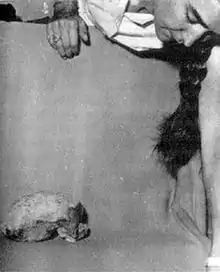
Stone hand-axes from early hominoids, probably Homo erectus, have been unearthed in Lenggong. They date back 1.83 million years, the oldest evidence of hominid habitation in Southeast Asia.[5] The earliest evidence of modern human habitation in Malaysia is the 40,000-year-old skull excavated from the Niah Caves in today's Sarawak, nicknamed "Deep Skull". It was excavated from a deep trench uncovered by Barbara and Tom Harrisson (a British ethnologist) in 1958.[6][7][8] this is also the oldest modern human skull in Southeast Asia.[9] The skull probably belongs to a 16-to 17-year-old adolescent girl.[10] The first foragers visited the West Mouth of Niah Caves (located 110 kilometres (68 mi) southwest of Miri)[7] 40,000 years ago when Borneo was connected to the mainland of Southeast Asia. The landscape around the Niah Caves was drier and more exposed than it is now. Prehistorically, the Niah Caves were surrounded by a combination of closed forests with bush, parkland, swamps, and rivers. The foragers were able to survive in the rainforest through hunting, fishing, and gathering molluscs and edible plants.[10] Mesolithic and Neolithic burial sites have also been found in the area.[11] The area around the Niah Caves has been designated the Niah National Park.[12]
A study of Asian genetics points to the idea that the original humans in East Asia came from Southeast Asia.[13] The oldest complete skeleton found in Malaysia is 11,000-year-old Perak Man unearthed in 1991.[14] The indigenous groups on the peninsula can be divided into three ethnicities, the Negritos, the Senoi, and the proto-Malays.[15] The first inhabitants of the Malay Peninsula were most probably Negritos.[16] These Mesolithic hunters were probably the ancestors of the Semang, an ethnic Negrito group who have a long history in the Malay Peninsula.[17]
The Senoi appear to be a composite group, with approximately half of the maternal mitochondrial DNA lineages tracing back to the ancestors of the Semang and about half to later ancestral migrations from Indochina. Scholars suggest they are descendants of early Austroasiatic-speaking agriculturalists, who brought both their language and their technology to the southern part of the peninsula approximately 4,000 years ago. They united and coalesced with the indigenous population.[18]
.tif.jpg.webp)
The Proto Malays have a more diverse origin[19] and had settled in Malaysia by 1000 BC as a result of Austronesian expansion.[20] Although they show some connections with other inhabitants in Maritime Southeast Asia, some also have an ancestry in Indochina around the time of the Last Glacial Maximum about 20,000 years ago. Anthropologists support the notion that the Proto-Malays originated from what is today Yunnan, China.[21] This was followed by an early-Holocene dispersal through the Malay Peninsula into the Malay Archipelago.[22] Around 300 BC, they were pushed inland by the Deutero-Malays, an Iron Age or Bronze Age people descended partly from the Chams of Cambodia and Vietnam. The first group in the peninsula to use metal tools, the Deutero-Malays were the direct ancestors of today's Malaysian Malays, and brought with them advanced farming techniques.[17] The Malays remained politically fragmented throughout the Malay archipelago, although a common culture and social structure was shared.[23]
Early Indianised Hindu-Buddhist kingdoms
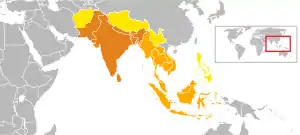
In the first millennium CE, Malays became the dominant race on the peninsula. The small early states that were established were greatly influenced by Indian culture, as was most of Southeast Asia.[25] Indian influence in the region dates back to at least the 3rd century BCE. South Indian culture was spread to Southeast Asia by the south Indian Pallava dynasty in the 4th and 5th centuries.[26]
Early Malay trade with India/China
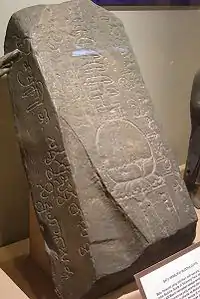
In ancient Indian literature, the term Suvarnadvipa or the "Golden Peninsula" is used in Ramayana, and some argued that it may be a reference to the Malay Peninsula. The ancient Indian text Vayu Purana also mentioned a place named Malayadvipa where gold mines may be found, and this term has been proposed to mean possibly Sumatra and the Malay Peninsula.[27] The Malay Peninsula was shown on Ptolemy's map as the "Golden Khersonese". He referred to the Straits of Malacca as Sinus Sabaricus.[28]
Trade relations with China and India were established in the 1st century BC.[29] Shards of Chinese pottery have been found in Borneo dating from the 1st century following the southward expansion of the Han Dynasty.[30] In the early centuries of the first millennium, the people of the Malay Peninsula adopted the Indian religions of Hinduism and Buddhism, religions which had a major effect on the language and culture of those living in Malaysia.[31] The Sanskrit writing system was used as early as the 4th century.[32]
Indianised Hindu Malay kingdoms (3rd to 7th centuries)
There were numerous Malay kingdoms in the 2nd and 3rd centuries, as many as 30, mainly based on the Eastern side of the Malay peninsula.[25] Among the earliest kingdoms known to have been based in the Malay Peninsula is the ancient kingdom of Langkasuka, located in the northern Malay Peninsula and based somewhere on the west coast.[25] It was closely tied to Funan in Cambodia, which also ruled part of northern Malaysia until the 6th century. In the 5th century, the Kingdom of Pahang was mentioned in the Book of Song. According to the Sejarah Melayu ("Malay Annals"), the Khmer prince Raja Ganji Sarjuna founded the kingdom of Gangga Negara (modern-day Beruas, Perak) in the 700s. Chinese chronicles of the 5th century CE speak of a great port in the south called Guantoli, which is thought to have been in the Straits of Malacca. In the 7th century, a new port called Shilifoshi is mentioned, and this is believed to be a Chinese rendering of Srivijaya.
Gangga Negara
Gangga Negara is believed to be a lost semi-legendary Hindu kingdom mentioned in the Malay Annals that covered present day Beruas, Dinding and Manjung in the state of Perak, Malaysia with Raja Gangga Shah Johan as one of its kings. Gangga Negara means "a city on the Ganges" in Sanskrit,[33] the name derived from Ganganagar in northwest India where the Kambuja peoples inhabited. Researchers believe that the kingdom was centered at Beruas. Another Malay annal Hikayat Merong Mahawangsa known as Kedah Annals, Gangga Negara may have been founded by Merong Mahawangsa's son Raja Ganji Sarjuna of Kedah, allegedly a descendant of Alexander the Great or by the Khmer royalties no later than the 2nd century.
The first research into the Beruas kingdom was conducted by Colonel James Low in 1849 and a century later, by H.G. Quaritch Wales. According to the Museum and Antiquities Department, both researchers agreed that the Gangga Negara kingdom existed between 100 – 1000 CE[34] but could not ascertain the exact site. For years, villagers had unearthed artefacts believed to be from the ancient kingdoms, most of which are at present displayed at the Beruas Museum. Artefacts on display include a 128 kg cannon, swords, kris, coins, tin ingots, pottery from the Ming Dynasty and various eras, and large jars. They can be dated back to the 5th and 6th centuries.[35] Through these artefacts, it has been postulated that Pengkalan (Ipoh), Kinta Valley, Tanjung Rambutan, Bidor and Sungai Siput were part of the kingdom. Artifacts also suggest that the kingdom's centre might have shifted several times. Gangga Negara was renamed to Beruas after the establishment of Islam there.
Kedah
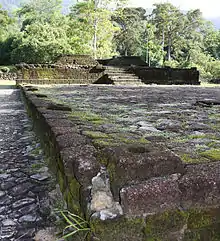
Ptolemy, a Greek geographer, astronomer, and astrologer, had written about Golden Chersonese, which indicates trade with India and China has existed since the 1st century AD.,[36]
As early as the 1st century AD, Southeast Asia was the place of a network of coastal city-states, the center of which was the ancient Khmer Funan kingdom in the south of what is now Vietnam. This network encompassed the southern part of the Indochinese peninsula and the western part of the Malay archipelago. These coastal cities had a continuous trade as well as tributary relations with China from a very early period, at the same time being in constant contact with Indian traders. They seem to have shared a common indigenous culture.
Gradually, the rulers of the western part of the archipelago adopted Indian cultural and political models e.g. proof of such Indian influence on Indonesian art in the 5th century. Three inscriptions found in Palembang (South Sumatra) and on Bangka Island, written in a form of Malay and in an alphabet derived from the Pallava script, are proof that the archipelago had definitely adopted Indian models while maintaining their indigenous language and social system. These inscriptions reveal the existence of a Dapunta Hyang (lord) of Srivijaya who led an expedition against his enemies and who curses those who will not obey his law.
Being on the maritime route between China and South India, the Malay peninsula was involved in this trade The Bujang Valley, being strategically located at the northwest entrance of the Strait of Malacca as well as facing the Bay of Bengal, was continuously frequented by Chinese and south Indian traders. Such was proven by the discovery of trade ceramics, sculptures, inscriptions and monuments dated from the 5th to 14th centuries CE.
The Bujang Valley was continuously administered by different thalassocratical powers including Funan, Srivijaya, and Majapahit before the trade declined.
In Kedah there are remains showing Buddhist and Hindu influences which have been known for about a century now from the discoveries reported by Col. Low and has recently been subjected to a fairly exhaustive investigation by Dr. Quaritch Wales. Dr. Wales investigated no fewer than thirty sites roundabout Kedah.
An inscribed stone bar, rectangular in shape, bears the ye-dharmma formula in Pallava script of the 7th century, thus proclaiming the Buddhist character of the shrine near the find-spot (site I) of which only the basement survives. It is inscribed on three faces in Pallava script of the 6th century, possibly earlier.
Except for the Cherok Tokkun Inscription which was engraved on a large boulder, other inscriptions discovered in Bujang Valley are comparatively small in size and probably were brought in by Buddhist pilgrimage or traders.
Indianised Hindu-Buddhist Malay kingdoms as vassal of Srivijaya empire (7th – 13th century)
Between the 7th and the 13th century, much of the Malay peninsula was under the Buddhist Srivijaya empire. The site of Srivijaya's centre is thought be at a river mouth in eastern Sumatra, based near what is now Palembang.[37] For over six centuries the Maharajahs of Srivijaya ruled a maritime empire that became the main power in the archipelago. The empire was based around trade, with local kings (dhatus or community leaders) swearing allegiance to the central lord for mutual profit.[38]
Relationship of Srivijaya empire with Indian Tamil Chola empire
The relation between Srivijaya and the Chola Empire of south India was friendly during the reign of Raja Raja Chola I but during the reign of Rajendra Chola I the Chola Empire invaded Srivijaya cities (see Chola invasion of Srivijaya).[39] In 1025 and 1026, Gangga Negara was attacked by Rajendra Chola I of the Chola Empire, the Tamil emperor who is now thought to have laid Kota Gelanggi to waste. Kedah—known as Kedaram, Cheh-Cha (according to I-Ching) or Kataha, in ancient Pallava or Sanskrit—was in the direct route of the invasions and was ruled by the Cholas from 1025. A second invasion was led by Virarajendra Chola of the Chola dynasty who conquered Kedah in the late 11th century.[40] The senior Chola's successor, Vira Rajendra Chola, had to put down a Kedah rebellion to overthrow other invaders. The coming of the Chola reduced the majesty of Srivijaya, which had exerted influence over Kedah, Pattani and as far as Ligor. During the reign of Kulothunga Chola I Chola overlordship was established over the Srivijaya province kedah in the late 11th century.[41] The expedition of the Chola Emperors had such a great impression to the Malay people of the medieval period that their name was mentioned in the corrupted form as Raja Chulan in the medieval Malay chronicle Sejarah Melaya.[42][43][44] Even today the Chola rule is remembered in Malaysia as many Malaysian princes have names ending with Cholan or Chulan, one such was the Raja of Perak called Raja Chulan.[45][46]
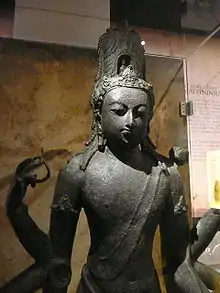
Pattinapalai, a Tamil poem of the 2nd century CE, describes goods from Kedaram heaped in the broad streets of the Chola capital. A 7th-century Indian drama, Kaumudhimahotsva, refers to Kedah as Kataha-nagari. The Agnipurana also mentions a territory known as Anda-Kataha with one of its boundaries delineated by a peak, which scholars believe is Gunung Jerai. Stories from the Katasaritasagaram describe the elegance of life in Kataha. The Buddhist kingdom of Ligor took control of Kedah shortly after. Its king Chandrabhanu used it as a base to attack Sri Lanka in the 11th century and ruled the northern parts, an event noted in a stone inscription in Nagapattinum in Tamil Nadu and in the Sri Lankan chronicles, Mahavamsa.
Decline of Srivijaya empire and inner fights of breakup vassal states (12th – 13th century)
At times, the Khmer kingdom, the Siamese kingdom, and even Cholas kingdom tried to exert control over the smaller Malay states.[25] The power of Srivijaya declined from the 12th century as the relationship between the capital and its vassals broke down. Wars with the Javanese caused it to request assistance from China, and wars with Indian states are also suspected. In the 11th century, the centre of power shifted to Malayu, a port possibly located further up the Sumatran coast near the Jambi River.[38] The power of the Buddhist Maharajas was further undermined by the spread of Islam. Areas which were converted to Islam early, such as Aceh, broke away from Srivijaya's control. By the late 13th century, the Siamese kings of Sukhothai had brought most of Malaya under their rule. In the 14th century, the Hindu Java-based Majapahit empire came into possession of the peninsula.[37]
An excavation by Tom Harrisson in 1949 unearthed a series of Chinese ceramics at Santubong (near Kuching) that date to the Tang and the Song dynasties in the 8th to 13th centuries AD. It is possible that Santubong was an important seaport in Sarawak during the period, but its importance declined during the Yuan dynasty, and the port was deserted during the Ming dynasty.[47] Other archaeological sites in Sarawak can be found inside the Kapit, Song, Serian, and Bau districts.[48]
After decades of Javanese domination, there were several last efforts made by Sumatran rulers to revive the old prestige and fortune of Malay-Srivijayan Mandala. Several attempts to revive Srivijaya were made by the fleeing princes of Srivijaya. According to the Malay Annals, a new ruler named Sang Sapurba was promoted as the new paramount of Srivijayan mandala. It was said that after his accession to Seguntang Hill with his two younger brothers, Sang Sapurba entered into a sacred covenant with Demang Lebar Daun, the native ruler of Palembang.[49] The newly installed sovereign afterwards descended from the hill of Seguntang into the great plain of the Musi river, where he married Wan Sendari, the daughter of the local chief, Demang Lebar Daun. Sang Sapurba was said to have reigned in Minangkabau lands.
In 1324, a Srivijaya prince, Sri Maharaja Sang Utama Parameswara Batara Sri Tribuwana (Sang Nila Utama), founded the Kingdom of Singapura (Temasek). According to tradition, he was related to Sang Sapurba. He maintained control over Temasek for 48 years. He was recognized as ruler over Temasek by an envoy of the Chinese Emperor sometime around 1366. He was succeeded by his son Paduka Sri Pekerma Wira Diraja (1372–1386) and grandson, Paduka Seri Rana Wira Kerma (1386–1399). In 1401, the last ruler, Paduka Sri Maharaja Parameswara, was expelled from Temasek by forces from Majapahit or Ayutthaya. He later headed north and founded the Sultanate of Malacca in 1402.[50]:245–246 The Sultanate of Malacca succeeded the Srivijaya Empire as a Malay political entity in the archipelago.[51][52]
Rise of Muslim states
Islam came to the Malay Archipelago through the Arab and Indian traders in the 13th century, ending the age of Hinduism and Buddhism.[53] It arrived in the region gradually, and became the religion of the elite before it spread to the commoners. The syncretic form of islam in Malaysia was influenced by previous religions and was originally not orthodox.[25]
Establishment
The port of Malacca on the west coast of the Malay Peninsula was founded in 1400 by Parameswara, a Srivijayan prince fleeing Temasek (now Singapore),[25] Parameswara in particular sailed to Temasek to escape persecution. There he came under the protection of Temagi, a Malay chief from Patani who was appointed by the king of Siam as regent of Temasek. Within a few days, Parameswara killed Temagi and appointed himself regent. Some five years later he had to leave Temasek, due to threats from Siam. During this period, a Javanese fleet from Majapahit attacked Temasek.
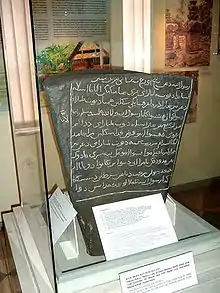
Parameswara headed north to found a new settlement. At Muar, Parameswara considered siting his new kingdom at either Biawak Busuk or at Kota Buruk. Finding that the Muar location was not suitable, he continued his journey northwards. Along the way, he reportedly visited Sening Ujong (former name of present-day Sungai Ujong) before reaching a fishing village at the mouth of the Bertam River (former name of the Melaka River), and founded what would become the Malacca Sultanate. Over time this developed into modern-day Malacca Town. According to the Malay Annals, here Parameswara saw a mouse deer outwitting a dog resting under a Malacca tree. Taking this as a good omen, he decided to establish a kingdom called Malacca. He built and improved facilities for trade. The Malacca Sultanate is commonly considered the first independent state in the peninsula.[54]
In 1404, the first official Chinese trade envoy led by Admiral Yin Qing arrived in Malacca. Later, Parameswara was escorted by Zheng He and other envoys in his successful visits. Malacca's relationships with Ming granted protection to Malacca against attacks from Siam and Majapahit and Malacca officially submitted as a protectorate of Ming China. This encouraged the development of Malacca into a major trade settlement on the trade route between China and India, Middle East, Africa and Europe.[56] To prevent the Malaccan empire from falling to the Siamese and Majapahit, he forged a relationship with the Ming dynasty of China for protection.[57][58] Following the establishment of this relationship, the prosperity of the Malacca entrepôt was then recorded by the first Chinese visitor, Ma Huan, who travelled together with Admiral Zheng He.[59][55] In Malacca during the early 15th century, Ming China actively sought to develop a commercial hub and a base of operation for their treasure voyages into the Indian Ocean.[60] Malacca had been a relatively insignificant region, not even qualifying as a polity prior to the voyages according to both Ma Huan and Fei Xin, and was a vassal region of Siam.[60] In 1405, the Ming court dispatched Admiral Zheng He with a stone tablet enfeoffing the Western Mountain of Malacca as well as an imperial order elevating the status of the port to a country.[60] The Chinese also established a government depot (官廠) as a fortified cantonment for their soldiers.[60] Ma Huan reported that Siam did not dare to invade Malacca thereafter.[60] The rulers of Malacca, such as Parameswara in 1411, would pay tribute to the Chinese emperor in person.[60]
The emperor of Ming dynasty China was sending out fleets of ships to expand trade. Admiral Zheng He called at Malacca and brought Parameswara with him on his return to China, a recognition of his position as legitimate ruler of Malacca. In exchange for regular tribute, the Chinese emperor offered Melaka protection from the constant threat of a Siamese attack. Because of its strategic location, Malacca was an important stopping point for Zheng He's fleet.[61] Due to Chinese involvement, Malacca had grown as key alternative to other important and established ports.[lower-alpha 1]The Chinese and Indians who settled in the Malay Peninsula before and during this period are the ancestors of today's Baba-Nyonya and Chitty community. According to one theory, Parameswara became a Muslim when he married a Princess of Pasai and he took the fashionable Persian title "Shah", calling himself Iskandar Shah.[58] Chinese chronicles mention that in 1414, the son of the first ruler of Malacca visited the Ming emperor to inform them that his father had died. Parameswara's son was then officially recognised as the second ruler of Melaka by the Chinese Emperor and styled Raja Sri Rama Vikrama, Raja of Parameswara of Temasek and Malacca and he was known to his Muslim subjects as Sultan Sri Iskandar Zulkarnain Shah or Sultan Megat Iskandar Shah. He ruled Malacca from 1414 to 1424.[62] Through the influence of Indian Muslims and, to a lesser extent, Hui people from China, Islam became increasingly common during the 15th century.
Rise of Malacca
After an initial period paying tribute to the Ayutthaya,[25] the kingdom rapidly assumed the place previously held by Srivijaya, establishing independent relations with China, and exploiting its position dominating the Straits to control the China-India maritime trade, which became increasingly important when the Mongol conquests closed the overland route between China and the west.
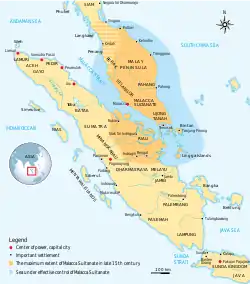
Within a few years of its establishment, Malacca officially adopted Islam. Parameswara became a Muslim, and because Malacca was under a Muslim prince, the conversion of Malays to Islam accelerated in the 15th century.[37] The political power of the Malacca Sultanate helped Islam's rapid spread through the archipelago. Malacca was an important commercial centre during this time, attracting trade from around the region.[37] By the start of the 16th century, with the Malacca Sultanate in the Malay peninsula and parts of Sumatra,[63] the Demak Sultanate in Java,[64] and other kingdoms around the Malay archipelago increasingly converting to Islam,[65] it had become the dominant religion among Malays, and reached as far as the modern-day Philippines, leaving Bali as an isolated outpost of Hinduism today.
Malacca's reign lasted little more than a century, but during this time became the established centre of Malay culture. Most future Malay states originated from this period.[53] Malacca became a cultural centre, creating the matrix of the modern Malay culture: a blend of indigenous Malay and imported Indian, Chinese and Islamic elements. Malacca's fashions in literature, art, music, dance and dress, and the ornate titles of its royal court, came to be seen as the standard for all ethnic Malays. The court of Malacca also gave great prestige to the Malay language, which had originally evolved in Sumatra and been brought to Malacca at the time of its foundation. In time Malay came to be the official language of all the Malaysian states, although local languages survived in many places. After the fall of Malacca, the Sultanate of Brunei became the major centre of Islam.[66][67]
16th-17th century Politics in the Malayan Peninsular
From the 15th century onwards, the Portuguese started seeking a maritime route towards Asia. In 1511, Afonso de Albuquerque led an expedition to Malaya which seized Malacca with the intent of using it as a base for activities in southeast Asia.[25] This was the first colonial claim on what is now Malaysia.[37] The son of the last Sultan of Malacca, Sultan Alauddin Riayat Shah II fled to the southern tip of the peninsula, where he founded a state that which became the Sultanate of Johor.[25] Another son created the Perak Sultanate to the north. By the late 16th century, the tin mines of northern Malaya had been discovered by European traders, and Perak grew wealthy on the proceeds of tin exports.[38] Portuguese influence was strong, as they aggressively tried to convert the population of Malacca to Catholicism.[25] In 1571, the Spanish captured Manila and established a colony in the Philippines, reducing the Sultanate of Brunei's power.[67]
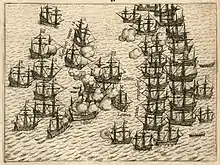
After the fall of Malacca to Portugal, the Johor Sultanate on the southern Malay peninsula and the Sultanate of Aceh on northern Sumatra moved to fill the power vacuum left behind.[25] The three powers struggled to dominate the Malay peninsula and the surrounding islands.[38] Meanwhile, the importance of the Strait of Malacca as an East-West shipping route was growing, while the islands of Southeast Asia were themselves prized sources of natural resources (metals, spices, etc.) whose inhabitants were being further drawn in the global economy.
In 1607, the Sultanate of Aceh rose as the powerful and wealthiest state in the Malay archipelago. Under Iskandar Muda's reign, the sultanate's control was extended over a number of Malay states. A notable conquest was Perak, a tin-producing state on the Peninsula.[38] In Iskandar Muda's disastrous campaign against Malacca in 1629, the combined Portuguese and Johor forces managed to destroy all the ships of his formidable fleet and 19,000 troops according to a Portuguese account.[68] Aceh forces were not destroyed, however, as Aceh was able to conquer Kedah within the same year and took many of its citizens to Aceh. The Sultan's son-in-law, Iskandar Thani, the former prince of Pahang later became Iskandar Muda's successor. The conflict over control of the straits went on until 1641, when the Dutch (allied to Johor) gained control of Malacca.
In the early 17th century, the Dutch East India Company (Vereenigde Oost-Indische Compagnie, or VOC) was established. During this time the Dutch were at war with Spain, which absorbed the Portuguese Empire due to the Iberian Union. The Dutch expanded across the archipelago, forming an alliance with Johor and using this to push the Portuguese out of Malacca in 1641.[25] Backed by the Dutch, Johor established a loose hegemony over the Malay states, except Perak, which was able to play-off Johor against the Siamese to the north and retain its independence.[69] The Dutch did not interfere in local matters in Malacca, but at the same time diverted most trade to its colonies on Java.[25]
Johor Sultanate
The Johor Sultanate was founded by Sultan Alauddin Riayat Shah II of Malacca in 1528, the son of Sultan Mahmud Shah of Malacca. Johor was part of the Malaccan Sultanate before the Portuguese conquered the port town of Malacca in 1511. At its height, the sultanate controlled modern-day Johor, several territories by the Klang and Linggi rivers, Singapore, Bintan, Riau, Lingga, Karimun, Bengkalis, Kampar and Siak in Sumatra.[70] The Portuguese and Johor were frequently in conflict in the 16th century, conflict erupted most notably in the 1587 siege of Johor. In the so called "Triangular war", Aceh launched multiple raids against both Johor and Portuguese forces to tighten its grip over the straits. The rise and expansion of Aceh encouraged the Portuguese and Johor to sign a truce to divert their attention to Aceh. The truce, however, was short-lived and with Aceh severely weakened, Johor and the Portuguese had each other in their sights again. During the rule of Sultan Iskandar Muda, Aceh attacked Johor in 1613 and again in 1615.[71]
In the early 17th century, the Dutch reached Southeast Asia. At that time the Dutch were at war with the Portuguese and allied themselves to Johor. Two treaties were signed by Admiral Cornelis Matelief de Jonge on behalf of the Dutch Estates General and Raja Bongsu (Raja Seberang) of Johor in May and September 1606.[72] The combined Johor-Dutch forces ultimately failed to capture Malacca in 1606. Finally in 1641, the Dutch and Johor headed by Bendahara Skudai, defeated the Portuguese in the Battle of Malacca. The Dutch took control of Malacca and agreed not to seek territories or wage war with Johor. By the time the fortress at Malacca surrendered, the town's population had already been greatly decimated by famine and disease.[73]
With the fall of Portuguese Malacca in 1641 and the decline of Aceh due to the growing power of the Dutch, Johor started to re-establish itself as a power along the Straits of Malacca during the reign of Sultan Abdul Jalil Shah III (1623–1677).[74] During the triangular war, Jambi also emerged as a regional economic and political power in Sumatra. Initially there was an attempt of an alliance between Johor and Jambi by way of a promised marriage. However, the alliance broke down and a 13-year war then ensued between Johor and the Sumatran state beginning in 1666. After the sacking of Batu Sawar in 1673, the capital of Johor was frequently moved to avoid the threat of attack from Jambi. The Sultan escaped to Pahang and died four years later. His successor, Sultan Ibrahim (1677–1685), then engaged the help of the Bugis in the fight to defeat Jambi.[75] Johor would eventually prevail in 1679, but also ended in a weakened position as the Bugis refused to return to Makassar where they came from. On top of this, the Minangkabaus of Sumatra also started to assert their influence.[76]
In the 1690s the Bugis, who played an important role in defeating Jambi two decades earlier, had a huge influence in Johor. Both the Bugis and the Minangkabau realised how the death of Sultan Mahmud II in 1699 had provided them with the chance to exert power in Johor. The Minangkabau introduced a Minangkabau prince, Raja Kecil from Siak who claimed he was the posthumous son of Sultan Mahmud II. Raja Kecil then installed himself as the new Sultan of Johor (Sultan Abdul Jalil Rahmat Shah) without the knowledge of the Bugis. Dissatisfied with Raja Kecil's accession, Raja Sulaiman, asked Daeng Parani of the Bugis to aid him in his quest to reclaim the throne. In 1722, Raja Kecil was dethroned by Raja Sulaiman's supporters with the assistance of the Bugis. Raja Sulaiman became the new Sultan of Johore, but he was a weak ruler and became a puppet of the Bugis.[77]
Perak Sultanate
Based on Salasilah Raja-Raja Perak (Perak Royal Genealogy), the Perak Sultanate was formed in the early 16th century on the banks of the Perak River by the eldest son of Mahmud Shah, the 8th Sultan of Malacca.[78][79][80] He ascended to the throne as Muzaffar Shah I, first sultan of Perak, after surviving the capture of Malacca by the Portuguese in 1511 and living quietly for a period in Siak on the island of Sumatra. He became sultan through the efforts of Tun Saban, a local leader and trader between Perak and Klang.[79] There had been no sultan in Perak when Tun Saban first arrived in the area from Kampar in Sumatra.[81] Most of the area's residents were traders from Malacca, Selangor and Sumatra.
Perak's administration became more organised after the Sultanate was established. In democratic Malacca, government was based on the feudal system.[82] With the opening up of Perak in the 16th century, the state became a source of tin ore. It appears that anyone was free to trade in the commodity, although the tin trade did not attract significant attention until the 1610s.[83][84]
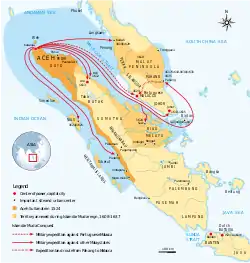
Throughout the 1570s, the Sultanate of Aceh subjected most parts of the Malay Peninsula to continual harassment.[79][85] Although Perak did fall under the authority of the Acehnese Sultanate, it remained entirely independent of Siamese control for over two hundred years from 1612,[85][86] in contrast with its neighbour, Kedah, and many of the Malay sultanates in the northern part of the Malay Peninsula, which became tributary states of Siam.[87][88]
When the last and 9th sultan of Perak of Malaccan lineage, Sultan Sallehuddin Riayat Shah died without an heir in 1635, a state of uncertainty prevailed in Perak. This was exacerbated by a deadly cholera epidemic that swept through the state, killing many royal family members.[79] Perak chieftains were left with no alternative but to turn to Aceh's Sultan Iskandar Thani, who sent his relative, Raja Sulong, to become the new Perak Sultan Muzaffar Shah II.
Arrival of the Dutch
Aceh's influence on Perak began to wane when the Dutch East India Company (VOC) arrived, in the mid–17th century.[85] When Perak refused to enter into a contract with the VOC as its northern neighbours had done, a blockade of the Perak River halted the tin trade, causing suffering among Aceh's merchants.[89] In 1650, Aceh's Sultana Taj ul-Alam ordered Perak to sign an agreement with the VOC, on condition that the tin trade would be conducted exclusively with Aceh's merchants.[78][89][90][91] By the following year, 1651, the VOC had secured a monopoly over the tin trade, setting up a store in Perak.[92] Following long competition between Aceh and the VOC over Perak's tin trade,[93] on 15 December 1653, the two parties jointly signed a treaty with Perak granting the Dutch exclusive rights to tin extracted from mines located in the state.[79][94]
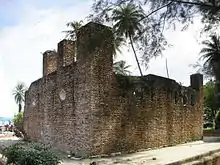
A fort was built on Pangkor Island in 1670 as a warehouse to store tin ore mined in Perak.[92] but was destroyed in further attacks in 1690 by local natives. It was then repaired when the Dutch returned with reinforcements.[92] In 1747, Sultan Muzaffar Riayat Shah III, who held power in the area of Upper Perak, signed a treaty with Dutch Commissioner Ary Verbrugge under which Perak's ruler recognised the Dutch monopoly over the tin trade, agreed to sell all tin ore to Dutch traders, and allowed the Dutch to build a new warehouse fort on the Perak River estuary.[95]
Pahang Sultanate
The Old Pahang Sultanate centred in modern-day Pekan was established in the 15th century. At the height of its influence, the Sultanate was an important power in Southeast Asian history and controlled the entire Pahang basin, bordering the Pattani Sultanate and the Johor Sultanate.[96] The sultanate has its origins as a vassal to the Malaccan Sultanate. Its first Sultan was a Malaccan prince, Muhammad Shah, himself the grandson of Dewa Sura, the last pre-Malaccan ruler of Pahang.[96] Over the years, Pahang grew independent from Malaccan control and at one point even established itself as a rival state to Malacca[97] until the latter's demise in 1511. In 1528, when the last Malaccan Sultan died, Pahang joined forces with his successor, Alauddin Riayat Shah II who established himself in Johor to expel the Portuguese from the Malay Peninsula. Two attempts were made in 1547 at Muar and in 1551 at Portuguese Malacca. However, in the face of superior Portuguese arms and vessels, the Pahang and Johor forces were forced to retreat on both occasions.[98]
During the reign of Sultan Abdul Kadir (1560–1590), Pahang enjoyed a brief period of cordial relations with the Portuguese. However in 1607, following a visit by Admiral Matelief de Jonge of the Dutch Empire, Pahang cooperated with them in an attempt to get rid of the Portuguese.[98] There was an attempt to establish a Johor-Pahang alliance to assist the Dutch. However, a quarrel erupted between Sultan Abdul Ghafur of Pahang and Alauddin Riayat Shah III of Johor, resulted in Johor declaring war on Pahang in 1612. With the aid of Sultan Abdul Jalilul Akbar of Brunei, Pahang eventually defeated Johor in 1613. In 1615, the Acehnese under Iskandar Muda invaded Pahang, forcing Alauddin Riayat Shah, son of Sultan Abdul Ghafur to retreat into the interior of Pahang. He nevertheless continued to exercise some ruling powers. His reign in exile is considered officially ended after the installation of a distant relative, Raja Bujang to the Pahang throne in 1615, with the support of the Portuguese following a pact between the Portuguese and Sultan of Johor.[98] Sultan Abdul Jalil Shah was eventually deposed in the Acehnese invasion of 1617, but restored to the Pahang throne and also installed as the new Sultan of Johor following the death of his uncle, Abdullah Ma'ayat Shah in 1623. This event led to the union of the crown of Pahang and Johor, and the formal establishment of Johor Empire.[98]
Selangor Sultanate
During the 17th century Johor-Jambi war, the Sultan of Johor engaged the help of Bugis mercenaries from Sulawesi to fight against Jambi.[75] After Johor won in 1679, the Bugis decided to stay and asserted their power in the region.[76] Many Bugis began to migrate and settled along the coast of Selangor such as the estuaries of Selangor and Klang rivers. Some Minangkabaus may have also settled in Selangor by the 17th century, perhaps earlier.[99] The Bugis and the Minangkabaus from Sumatra struggled for control of Johor; Raja Kecil, backed by the Minangkabaus, invaded Selangor but were driven off by the Bugis in 1742. To establish a power base, the Bugis led by Raja Salehuddin founded the present hereditary Selangor Sultanate with its capital at Kuala Selangor in 1766.[100] Selangor is unique as the only state on the Malay Peninsula that was founded by the Bugis.[101]
Bruneian Empire
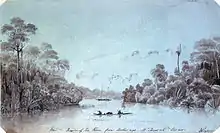
Before its conversion to Islam, Brunei was known as Poni and it was a vassal-state to the Majapahit Empire.[102] By the 15th century, the empire became a Muslim state, when the King of Brunei converted to Islam, brought by Muslim Indians and Arab merchants from other parts of Maritime Southeast Asia, who came to trade and spread Islam.[103][104] During the rule of Bolkiah, the fifth Sultan, the empire controlled the coastal areas of northwest Borneo (present-day Brunei, Sarawak and Sabah) and reached the Philippines at Seludong (present-day Manila), Sulu Archipelago and included parts of the island of Mindanao.[105][106][107][108][109][110][111][112] In the 16th century, the Brunei empire's influence also extended as far as Kapuas River delta in West Kalimantan.
Other sultanates in the area had close relations with the Royal House of Brunei, being in some cases effectively under the hegemony of the Brunei ruling family for periods of time, such as the Malay sultans of Pontianak, Samarinda and as far as Banjarmasin who treated the Sultan of Brunei as their leader. The Malay Sultanate of Sambas in present-day West Kalimantan and Sultanate of Sulu in Southern Philippines in particular had developed dynastic relations with the royal house of Brunei. The Sultanate of Sarawak (covering present day Kuching, known to the Portuguese cartographers as Cerava, and one of the five great seaports on the island of Borneo), though under the influence of the Brunei, was self-governed under Sultan Tengah before being fully integrated into the Bruneian Empire upon the Tengah's death in 1641.[113][114][115]
The Bruneian empire began to decline during the arrival of western powers. Spain sent several expeditions from Mexico to invade Brunei's territories in the Philippines. They conquered the Bruneian colony of Islamic Manila, Christianized its people, and laid siege to Sulu. Eventually the Spanish, their Visayan allies and their Latin-American recruits assaulted Brunei itself during the Castilian War. The invasion was only temporary as the Spanish then retreated.[116] However, Brunei was unable to regain the territory it lost in the Philippines. Yet, it still maintained sway in Borneo. By the early 19th century, Sarawak had become a loosely governed territory under the control of the Brunei Sultanate. The Bruneian Empire had authority only along the coastal regions of Sarawak held by semi-independent Malay leaders. Meanwhile, the interior of Sarawak suffered from tribal wars fought by Iban, Kayan, and Kenyah peoples, who aggressively fought to expand their territories.[117]
Following the discovery of antimony ore in the Kuching region, Pangeran Indera Mahkota (a representative of the Sultan of Brunei) began to develop the territory between 1824 and 1830. When antimony production increased, the Brunei Sultanate demanded higher taxes from Sarawak; this led to civil unrest and chaos.[118] In 1839, Sultan Omar Ali Saifuddin II (1827–1852), ordered his uncle Pengiran Muda Hashim to restore order. It was around this time that James Brooke (who would later become the first White Rajah of Sarawak) arrived in Sarawak, and Pengiran Muda Hashim requested his assistance in the matter, but Brooke refused.[119] However, he agreed to a further request during his next visit to Sarawak in 1841. Pangeran Muda Hashim signed a treaty in 1841 surrendering Sarawak to Brooke. On 24 September 1841,[120] Pengiran Muda Hashim bestowed the title of governor on James Brooke. This appointment was later confirmed by the Sultan of Brunei in 1842.
In 1843, Pengiran Muda Hashim became the Sultan of Borneo.[121] After the disturbances in Sarawak were successfully quelled, James Brooke met Hashim in Kuching to ensure his promises were kept. Pengiran Muda Hashim agreed to honour his promise. The ceding of Kuching to Brooke marked the beginning of further cessation of territories to James Brooke and later, the North Borneo Company. The very same year, Brooke effectively became the Rajah of Sarawak and founded the White Rajah Dynasty of Sarawak.[122][123]
European colonisation and struggles for hegemony
The weakness of the small coastal Malay states led to the immigration of the Bugis, escaping from Dutch colonisation of Sulawesi, who established numerous settlements on the peninsula which they used to interfere with Dutch trade.[25] They seized control of Johor following the assassination of the last Sultan of the old Melaka royal line in 1699. Bugis expanded their power in the states of Johor, Kedah, Perak, and Selangor.[25] The Minangkabau from central Sumatra migrated into Malaya, and eventually established their own state in Negeri Sembilan. The fall of Johor left a power vacuum on the Malay Peninsula which was partly filled by the Siamese kings of Ayutthaya kingdom, who made the five northern Malay states—Kedah, Kelantan, Patani, Perlis, and Terengganu — their vassals. Johor's eclipse also left Perak as the unrivalled leader of the Malay states.
The economic importance of Malaya to Europe grew rapidly during the 18th century. The fast-growing tea trade between China and United Kingdom increased the demand for high-quality Malayan tin, which was used to line tea-chests. Malayan pepper also had a high reputation in Europe, while Kelantan and Pahang had gold mines. The growth of tin and gold mining and associated service industries led to the first influx of foreign settlers into the Malay world – initially Arabs and Indians, later Chinese.
Kedah
After the Fall of Ayutthaya in 1767, the Northern Malay Sultanates were freed from Siamese domination temporarily. In 1786, British trader Francis Light managed to obtain a lease of Penang Island from Sultan Abdullah Mukarram Shah on behalf of East India Company in exchange for military support against the Siamese or Burmese. However, Siam re-exerted control over Northern Malay Sultanates and sacked Pattani. Francis Light, however, failed to secure military assistance for the Malay states against Siam and Kedah came under Siamese suzerainty. King Rama II of Siam ordered Noi Na Nagara of Ligor to invade Kedah Sultanate in 1821. Under the Burney Treaty of 1826, the exiled Kedah Sultan Abdullah Mukarram Shah was not restored to his throne. He and his armed supporters then fought in a series of war known as Perang Musuh Bisik for his restoration over twelve years (1830–1842).[124]
When the Siamese army invaded and occupied Kedah between 1821 and 1842, local Arab families supported the Sultan's efforts to lead resistance efforts to persuade the Siamese to regain the state's independence. In 1842, Sultan Mukarram Shah finally agreed to accept Siamese terms and was restored to his throne of Kedah. The following year, Sayyid Hussein Jamal Al-Layl was installed by the Siamese as the first Raja of Perlis, after the Sultan of Kedah gave his endorsement for the formation of Perlis, Siam separated Perlis into a separate principality directly vassal to Bangkok.[125]
Kelantan
Around 1760, Long Yunus, an aristocratic warlord of Patani origin succeeded in unifying the territory of present-day Kelantan and was succeeded in 1795 by his son-in-law, Tengku Muhammad Sultan Mansur of Terengganu. The enthronement of Tengku Muhammad by Terengganu was opposed by Long Yunus' sons, thus triggering a war against Terengganu by Long Muhammad, the eldest son of Long Yunus. The pro-Terengganu faction was defeated in 1800 and Long Muhammad ruled Kelantan with the new title of Sultan as Sultan Muhammad I. However, in the Burney Treaty of 1826, the treaty acknowledged Siamese claims over several northern Malay states Kedah, Kelantan, Perlis, Terengganu—the future Unfederated Malay States—and Patani. The treaty further guaranteed British possession of Penang and their rights to trade in Kelantan and Terengganu without Siamese interference. Unfortunately, the five Malay-ethnic states were not represented in the treaty negotiation. In 1909 the parties of the agreement signed a new treaty that superseded the Burney Treaty and transferred four of the five Malay states from Siamese to British control, except for Patani.[126][127] As Patani was not included in the Anglo-Siamese Treaty of 1909 and remained under Siamese rule, this led Patani to be excluded from the Federation of Malaya in 1957.
British influence
.jpg.webp)
English traders had been present in Malay waters since the 17th century.[128] Before the mid-19th-century British interests in the region were predominantly economic, with little interest in territorial control. Already the strongest European power in India, the British were looking towards southeast Asia for new territories.[25] The growth of the China trade in British ships increased the East India Company's desire for bases in the region. Various islands were used for this purpose, but the first permanent acquisition was Penang, leased from the Sultan of Kedah in 1786.[129] This was followed soon after by the leasing of a block of territory on the mainland opposite Penang (known as Province Wellesley). In 1795, during the Napoleonic Wars, the British with the consent of the French-occupied Netherlands occupied Dutch Melaka to forestall possible French encroachment in the area.[37]
When Malacca was handed back to the Dutch in 1815, the British governor, Stamford Raffles, looked for an alternative base, and in 1819 he acquired Singapore from the Sultan of Johor.[130] The exchange of the British colony of Bencoolen for Malacca with the Dutch left the British as the sole colonial power on the peninsula.[25] The territories of the British were set up as free ports, attempting to break the monopoly held by the Dutch and French at the time, and making them large bases of trade. They allowed Britain to control all trade through the straits of Malacca.[25] British influence was increased by Malayan fears of Siamese expansionism, to which Britain made a useful counterweight. During the 19th century the Malay Sultans aligned themselves with the British Empire, due to the benefits of associations with the British and their fear of Siamese or Burmese incursions.[38]
In 1824, British control in Malaya (before the name Malaysia) was formalised by the Anglo-Dutch Treaty, which divided the Malay archipelago between Britain and the Netherlands. The Dutch evacuated Melaka[37] and renounced all interest in Malaya, while the British recognised Dutch rule over the rest of the East Indies. By 1826 the British controlled Penang, Malacca, Singapore, and the island of Labuan, which they established as the crown colony of the Straits Settlements,[25] administered first under the East India Company until 1867, when they were transferred to the Colonial Office in London.[38]
Colonial Era
British in Malaya
Initially, the British followed a policy of non-intervention in relations between the Malay states.[38][131] The commercial importance of tin mining in the Malay states to merchants in the Straits Settlements led to infighting between the aristocracy on the peninsula. The destabilisation of these states damaged the commerce in the area, causing the British to start to intervene. The wealth of Perak's tin mines made political stability there a priority for British investors, and Perak was thus the first Malay state to agree to the supervision of a British resident.[25] The Royal Navy was employed to bring about a peaceful resolution to civil disturbances caused by Chinese and Malay gangs employed in a political fight between Ngah Ibrahim and Raja Muda Abdullah. The Pangkor Treaty of 1874 paved the way for the expansion of British influence in Malaya. The British concluded treaties with some Malay states, installing residents who advised the Sultans and soon became the de facto rulers of their states.[132] These advisors held power in everything except to do with Malay religion and customs.[25]
Johor was the sole remaining state to maintain its independence, by modernising and giving British and Chinese investors legal protection. By the turn of the 20th century, the states of Pahang, Selangor, Perak, and Negeri Sembilan, known together as the Federated Malay States, had British advisors.[25] In 1909 the Siamese kingdom was compelled to cede Kedah, Kelantan, Perlis and Terengganu, which already had British advisors, over to the British.[25] Sultan Abu Bakar of Johor and Queen Victoria were personal acquaintances who recognised each other as equals. It was not until 1914 that Sultan Abu Bakar's successor, Sultan Ibrahim, accepted a British adviser.[133] The four previously Thai states and Johor were known as the Unfederated Malay States. The states under the most direct British control developed rapidly, becoming the largest suppliers in the world of first tin, then rubber.[25]
By 1910, the pattern of British rule in the Malay lands was established. The Straits Settlements were a Crown colony, ruled by a governor under the supervision of the Colonial Office in London. Their population was about roughly 50% Chinese-Malaysian, but all residents, regardless of race, were British subjects. The first four states to accept British residents, Perak, Selangor, Negeri Sembilan, and Pahang, were termed the Federated Malay States: while technically independent, they were placed under a Resident-General in 1895, making them British colonies in all but name. The Unfederated Malay States (Johore, Kedah, Kelantan, Perlis, and Terengganu) had a slightly larger degree of independence, although they were unable to avoid listening the wishes of their residents for long. Johor, as Britain's closest ally in Malay affairs, had the privilege of a written constitution, which gave the Sultan the right to appoint his own Cabinet, but he was generally careful to consult the British first.[131]
British in Borneo

During the late 19th century the British also gained control of the north coast of Borneo, where Dutch rule had never been established. Development on the Peninsula and Borneo were generally separate until the 19th century.[134] The eastern part of this region (now Sabah) was under the nominal control of the Sultan of Sulu, who later became a vassal of the Spanish East Indies. The rest was the territory of the Sultanate of Brunei. In 1841, British adventurer James Brooke helped the Sultan of Brunei suppress a revolt, and in return received the title of raja and the right to govern the Sarawak River District. In 1846, his title was recognised as hereditary, and the "White Rajahs" began ruling Sarawak as a recognised independent state. The Brookes expanded Sarawak at the expense of Brunei.[25]
In 1881, the British North Borneo Company was granted control of the territory of British North Borneo, appointing a governor and legislature. It was ruled from the office in London. Its status was similar to that of a British Protectorate, and like Sarawak it expanded at the expense of Brunei.[25] Until the Philippine independence on 1946, seven British-controlled islands in the north-eastern part of Borneo named Turtle Islands and Cagayan de Tawi-Tawi were ceded to the Philippine government by the Crown colony government of North Borneo.[135] The Philippines then under its irredentism motive since the administration of President Diosdado Macapagal laying claim to eastern Sabah in a basis the territory was part of the present-defunct Sultanate of Sulu's territory. In 1888, what was left of Brunei was made a British protectorate, and in 1891 another Anglo-Dutch treaty formalised the border between British and Dutch Borneo.
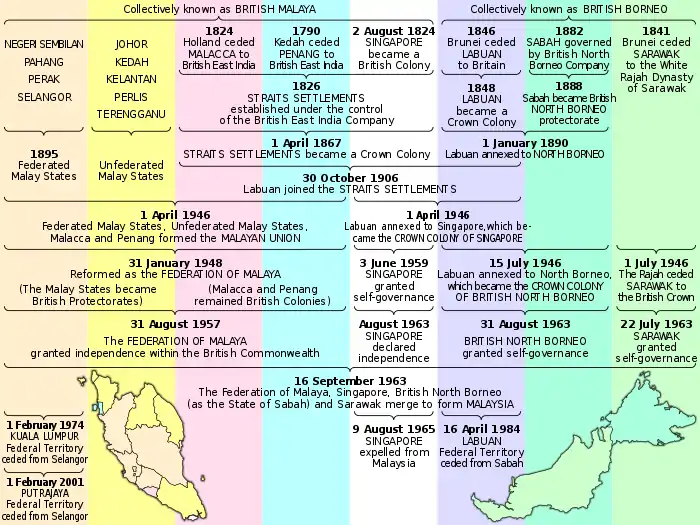
Race relations during colonial era
Unlike some colonial powers, the British always saw their empire as primarily an economic concern, and its colonies were expected to turn a profit for shareholders in London. Malaya's obvious attractions were its tin and gold mines, but British planters soon began to experiment with tropical plantation crops—tapioca, gambier, pepper, and coffee. But in 1877 the rubber plant was introduced from Brazil, and rubber soon became Malaya's staple export, stimulated by booming demand from European industry. Rubber was later joined by palm oil as an export earner.[136] All these industries required a large and disciplined labour force, and the British did not regard the Malays as reliable workers. The solution was the importation of plantation workers from British India, mainly Tamil-speakers from South India. A small group of Malabaris were brought from the current place called Kerala to help with the rubber plantations, resulting in the small Malabari population seen in Malaysia today. The mines, mills and docks also attracted a flood of immigrant workers from southern China. Soon towns like Singapore, Penang, and Ipoh were majority Chinese, as was Kuala Lumpur, founded as a tin-mining centre in 1857. By 1891, when Malaya's first census was taken, Perak and Selangor, the main tin-mining states, had Chinese majorities.[137]
The Chinese mostly arrived poor; yet their belief in industriousness and frugality, their emphasis in their children's education and their maintenance of Confucian family hierarchy, as well as their voluntary connection with tightly-knit networks of mutual aid societies (run by "Hui-Guan" 會館, or non-profit organisations with nominal geographic affiliations from different parts of China) all contributed to their prosperity. In the 1890s Yap Ah Loy, who held the title of Kapitan China of Kuala Lumpur, was the richest man in Malaya, owning a chain of mines, plantations and shops. Malaya's banking and insurance industries were run by the Chinese from the start, and Chinese businesses, usually in partnership with London firms, soon had complete control of the Malayan economy.[138] Since the Malay Sultans tended to spend well beyond their means, they were soon indebted to Chinese bankers, and this gave the Chinese political as well as economic leverage. At first the Chinese immigrants were mostly men, and many intended to return home when they had made their fortunes. Many did go home, but many more stayed. At first they married Malay women, producing a community of Sino-Malayans or baba people, but soon they began importing Chinese brides, establishing permanent communities and building schools and temples.[139]
The Indians were initially less successful, since unlike the Chinese they came mainly as indentured labourers to work in the rubber plantations, and had few of the economic opportunities that the Chinese had. They were also a less united community, since they were divided between Hindus and Muslims and along lines of language and caste. An Indian commercial and professional class emerged during the early 20th century, but the majority of Indians remained poor and uneducated in rural ghettos in the rubber-growing areas.[140]
Traditional Malay society had great difficulty coping with both the loss of political sovereignty to the British and of economic power to the Chinese. By the early 20th century, it seemed possible that the Malays would become a minority in their own country. The Sultans, who were seen as collaborators with both the British and the Chinese, lost some of their traditional prestige, particularly among the increasing number of Malays with a western education, but the mass of rural Malays continued to revere the Sultans.[141] A small class of Malay nationalist intellectuals began to emerge during the early 20th century, and there was also a revival of Islam in response to the perceived threat of other imported religions, particularly Christianity. In fact few Malays converted to Christianity, although many Chinese did. The northern regions, which were less influenced by western ideas, became strongholds of Islamic conservatism, as they have remained.[142]
The one consolation to Malay pride was that the British allowed them a virtual monopoly of positions in the police and local military units, as well as a majority of those administrative positions open to non-Europeans. While the Chinese mostly built and paid for their own schools and colleges, importing teachers from China, the colonial government fostered education for Malays, opening Malay College in 1905 and creating the Malay Administrative Service in 1910. (The college was dubbed "Bab ud-Darajat" – the Gateway to High Rank.)[143] A Malay Teachers College followed in 1922, and a Malay Women's Training College in 1935. All this reflected the official policy of the colonial administration that Malaya belonged to the Malays, and that the other races were but temporary residents. This view was increasingly out of line with reality, and contained the seeds of much future trouble.[144]
The Malay teacher's college had lectures and writings that nurtured Malay nationalist sentiments. Due to this it is known as the birthplace of Malay nationalism.[145] In 1938, Ibrahim Yaacob, an alumnus of Sultan Idris College, established the Kesatuan Melayu Muda (Young Malays Union or KMM) in Kuala Lumpur. It was the first nationalist political organisation in British Malaya, advocating for the union of all Malays regardless of origin, and advocating for the cause of Malays separate from the Indians and Chinese. A specific ideal the KMM held was Panji Melayu Raya, which called for the unification of British Malaya and the Dutch East Indies.[145]
In the years before World War II, the colonial government were concerned with finding the balance between a centralised state and maintaining the power of the Sultans in Malaya.[38] There were no moves to give Malaya a unitary government, and in fact, in 1935 the position of Resident-General of the Federated States was abolished, and its powers decentralised to the individual states. The colonial government regarded the Malays as amiable but unsophisticated and rather lazy, incapable of self-government, although making good soldiers. They regarded the Chinese as clever but dangerous—and indeed during the 1920s and 1930s, reflecting events in China, the Chinese Nationalist Party (the Kuomintang) and the Communist Party of China built rival clandestine organisations in Malaya, leading to regular disturbances in the Chinese towns. The colonial government saw no way that Malaya's disparate collection of states and races could become a single colony, let alone an independent nation.
World War II and the state of emergency
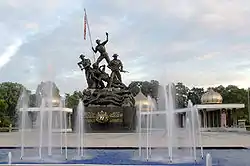
Although a belligerent as part of the British Empire, Malaya saw little action during World War I, except for the sinking of the Russian cruise Zhemchug by the German cruiser SMS Emden on 28 October 1914 during the Battle of Penang.
.jpg.webp)
The outbreak of war in the Pacific in December 1941 found the British in Malaya completely unprepared. During the 1930s, anticipating the rising threat of Japanese naval power, they had built a great naval base at Singapore, but never anticipated an invasion of Malaya from the north. Because of the demands of the war in Europe, there was virtually no British air capacity in the Far East. The Japanese were thus able to attack from their bases in French Indo-China with impunity, and despite stubborn resistance from British, Australian, and Indian forces, they overran Malaya in two months. Singapore, with no landward defences, no air cover, and no water supply, was forced to surrender in February 1942. British North Borneo and Brunei were also occupied.
The Japanese colonial government regarded the Malays from a pan-asian point of view, and fostered a limited form of Malay nationalism, which gained them some degree of collaboration from the Malay civil service and intellectuals. (Most of the Sultans also collaborated with the Japanese, although they maintained later that they had done so unwillingly.) The Malay nationalist Kesatuan Melayu Muda, advocates of Melayu Raya, collaborated with the Japanese, based on the understanding that Japan would unite the Dutch East Indies, Malaya and Borneo and grant them independence.[146] The occupiers regarded the Chinese, however, as enemy aliens, and treated them with great harshness: during the so-called sook ching (purification through suffering), up to 80,000 Chinese in Malaya and Singapore were killed. Chinese businesses were expropriated and Chinese schools either closed or burned down. Not surprisingly the Chinese, led by the Malayan Communist Party (MCP), became the backbone of the Malayan Peoples' Anti-Japanese Army (MPAJA), a force similar to the Soviet-supported Partisan rebel forces led by local Communist parties in the Eastern European theatre. With British assistance, the MPAJA became the most effective resistance force in the occupied Asian countries.
Although the Japanese argued that they supported Malay nationalism, they offended Malay nationalism by allowing their ally Thailand to re-annex the four northern states, Kedah, Perlis, Kelantan, and Terengganu that had been transferred to British Malaya in 1909. The loss of Malaya's export markets soon produced mass unemployment which affected all races and made the Japanese increasingly unpopular.
During occupation, ethnic tensions were raised and nationalism grew.[147] The Malayans were thus on the whole glad to see the British back in 1945, but things could not remain as they were before the war, and a stronger desire for independence grew.[148] Britain was bankrupt and the new Labour government was keen to withdraw its forces from the East as soon as possible. Colonial self-rule and eventual independence were now British policy. The tide of Asian nationalism sweeping through Asia soon reached Malaya. But most Malays were more concerned with defending themselves against the MCP which was mostly made up of Chinese, than with demanding independence from the British; indeed, their immediate concern was that the British not leave and abandon the Malays to the armed Communists of the MPAJA, which was the largest armed force in the country.
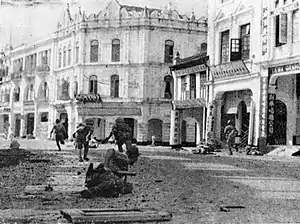
In 1944, the British drew up plans for a Malayan Union, which would turn the Federated and Unfederated Malay States, plus Penang and Malacca (but not Singapore), into a single Crown colony, with a view towards independence. The Bornean territories and Singapore were left out as it was thought this would make union more difficult to achieve.[38] There was however strong opposition from the Malays, who opposed the weakening of the Malay rulers and the granting of citizenship to the ethnic Chinese and other minorities.[149] The British had decided on legalised equality between all races as they perceived the Chinese and Indians as more loyal to the British during the war than the Malays.[38] The Sultans, who had initially supported it, backed down and placed themselves at the head of the resistance.
In 1946, the United Malays National Organisation (UMNO) was founded by Malay nationalists led by Dato Onn bin Jaafar, the Chief Minister of Johor.[38] UMNO favoured independence for Malaya, but only if the new state was run exclusively by the Malays. Faced with implacable Malay opposition, the British dropped the plan for equal citizenship. The Malayan Union was thus established in 1946, and was dissolved in 1948 and replaced by the Federation of Malaya, which restored the autonomy of the rulers of the Malay states under British protection.
Meanwhile, the Communists were moving towards open insurrection. The MPAJA had been disbanded in December 1945, and the MCP organised as a legal political party, but the MPAJA's arms were carefully stored for future use. The MCP policy was for immediate independence with full equality for all races. This meant it recruited very few Malays. The Party's strength was in the Chinese-dominated trade unions, particularly in Singapore, and in the Chinese schools, where the teachers, mostly born in China, saw the Communist Party of China as the leader of China's national revival. In March 1947, reflecting the international Communist movement's "turn to left" as the Cold War set in, the MCP leader Lai Tek was purged and replaced by the veteran MPAJA guerrilla leader Chin Peng, who turned the party increasingly to direct action. These rebels, under the leadership of the MCP, launched guerrilla operations designed to force the British out of Malaya. In July, following a string of assassinations of plantation managers, the colonial government struck back, declaring a State of emergency, banning the MCP and arresting hundreds of its militants. The Party retreated to the jungle and formed the Malayan Peoples' Liberation Army, with about 13,000 men under arms, all Chinese.
The Malayan Emergency as it was known, lasted from 1948 to 1960 and involved a long anti-insurgency campaign by Commonwealth troops in Malaya. The British strategy, which proved ultimately successful, was to isolate the MCP from its support base by a combination of economic and political concessions to the Chinese and the resettlement of Chinese squatters into "New Villages" in "white areas" free of MCP influence. From 1949 the MCP campaign lost momentum and the number of recruits fell sharply. Although the MCP succeeded in assassinating the British High Commissioner, Sir Henry Gurney, in October 1951, this turn to terrorist tactics alienated many moderate Chinese from the Party. The arrival of Lt.-Gen Sir Gerald Templer as British commander in 1952 was the beginning of the end of the Emergency. Templer helped create the modern techniques of Counter-insurgency warfare in Malaya and applied them against the MCP guerillas. Although the insurgency was defeated Commonwealth troops remained with the backdrop of the Cold War against the Soviet Union.[150] Against this backdrop, independence for the Federation within the Commonwealth was granted on 31 August 1957,[151] with Tunku Abdul Rahman as the first prime minister.[37]
Emergence of Malaysia
Struggle for independent Malaysia
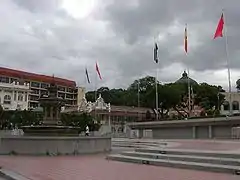
Chinese reaction against the MCP was shown by the formation of the Malayan Chinese Association (MCA) in 1949 as a vehicle for moderate Chinese political opinion. Its leader Tan Cheng Lock favoured a policy of collaboration with UMNO to win Malayan independence on a policy of equal citizenship, but with sufficient concessions to Malay sensitivities to ease nationalist fears. Tan formed a close collaboration with Tunku (Prince) Abdul Rahman, the Chief Minister of Kedah and from 1951 successor to Datuk Onn as leader of UMNO. Since the British had announced in 1949 that Malaya would soon become independent whether the Malayans liked it or not, both leaders were determined to forge an agreement their communities could live with as a basis for a stable independent state. The UMNO-MCA Alliance, which was later joined by the Malayan Indian Congress (MIC), won convincing victories in local and state elections in both Malay and Chinese areas between 1952 and 1955.[152]
The introduction of elected local government was another important step in defeating the Communists. After Joseph Stalin's death in 1953, there was a split in the MCP leadership over the wisdom of continuing the armed struggle. Many MCP militants lost heart and went home, and by the time Templer left Malaya in 1954, the Emergency was over, although Chin Peng led a diehard group that lurked in the inaccessible country along the Thai border for many years.
During 1955 and 1956 UMNO, the MCA and the British hammered out a constitutional settlement for a principle of equal citizenship for all races. In exchange, the MCA agreed that Malaya's head of state would be drawn from the ranks of the Malay Sultans, that Malay would be the official language, and that Malay education and economic development would be promoted and subsidised. In effect, this meant that Malaya would be run by the Malays, particularly since they continued to dominate the civil service, the army and the police, but that the Chinese and Indians would have proportionate representation in the Cabinet and the parliament, would run those states where they were the majority, and would have their economic position protected. The difficult issue of who would control the Education system was deferred until after independence. This came on 31 August 1957, when Tunku Abdul Rahman became the first Prime Minister of independent Malaya.
This left the unfinished business of the other British-ruled territories in the region. After the Japanese surrender the Brooke family and the British North Borneo Company gave up their control of Sarawak and North Borneo respectively, and these became British Crown Colonies. They were much less economically developed than Malaya, and their local political leaderships were too weak to demand independence. Singapore, with its large Chinese majority, achieved autonomy in 1955, and in 1959 the young leader Lee Kuan Yew became Prime Minister. The Sultan of Brunei remained as a British client in his oil-rich enclave. Between 1959 and 1962 the British government orchestrated complex negotiations between these local leaders and the Malayan government.
On 24 April 1961, Lee Kuan Yew proposed the idea of forming Malaysia during a meeting to Tunku Abdul Rahman, after which Tunku invited Lee to prepare a paper elaborating on this idea. On 9 May, Lee sent the final version of the paper to Tunku and then deputy Malayan Prime Minister Abdul Razak. There were doubts about the practicality of the idea but Lee assured the Malayan government of continued Malay political dominance in the new federation. Razak supported the idea of the new federation and worked to convince Tunku to back it.[153] On 27 May 1961, Abdul Rahman proposed the idea of forming "Malaysia", which would consist of Brunei, Malaya, North Borneo, Sarawak, and Singapore, all except Malaya still under British rule.[154][155][156] It was stated that this would allow the central government to better control and combat communist activities, especially in Singapore. It was also feared that if Singapore became independent, it would become a base for Chinese chauvinists to threaten Malayan sovereignty. The proposed inclusion of British territories besides Singapore was intended to keep the ethnic composition of the new nation similar to that of Malaya, with the Malay and indigenous populations of the other territories canceling out the Chinese majority in Singapore.[157]
Although Lee Kuan Yew supported the proposal, his opponents from the Singaporean Socialist Front (Barisan Sosialis) resisted, arguing that this was a ploy for the British to continue controlling the region. Most political parties in Sarawak were also against the merger, and in North Borneo, where there were no political parties, community representatives also stated their opposition. Although the Sultan of Brunei supported the merger, the Parti Rakyat Brunei opposed it as well. At the Commonwealth Prime Ministers Conference in 1961, Abdul Rahman explained his proposal further to its opponents. In October, he obtained agreement from the British government to the plan, provided that feedback be obtained from the communities involved in the merger.
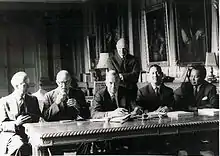
The Cobbold Commission, named after its head, Lord Cobbold, conducted a study in the Borneo territories and approved a merger with North Borneo and Sarawak; however, it was found that a substantial number of Bruneians opposed merger. North Borneo drew up a list of points, referred to as the 20-point agreement, proposing terms for its inclusion in the new federation. Sarawak prepared a similar memorandum, known as the 18-point agreement. Some of the points in these agreements were incorporated into the eventual constitution, some were instead accepted orally. These memoranda are often cited by those who believe that Sarawak's and North Borneo's rights have been eroded over time. A referendum was conducted in Singapore to gauge opinion, and 70% supported merger with substantial autonomy given to the state government.[158][159] The Sultanate of Brunei withdrew from the planned merger due to opposition from certain segments of its population as well as arguments over the payment of oil royalties and the status of the sultan in the planned merger.[131][152][160][161] Additionally, the Bruneian Parti Rakyat Brunei staged an armed revolt, which, though it was put down, was viewed as potentially destabilising to the new nation.[162]
After reviewing the Cobbold Commission's findings, the British government appointed the Landsdowne Commission to draft a constitution for Malaysia. The eventual constitution was essentially the same as the 1957 constitution, albeit with some rewording; for instance, giving recognition to the special position of the natives of the Borneo States. North Borneo, Sarawak and Singapore were also granted some autonomy unavailable to the states of Malaya. After negotiations in July 1963, it was agreed that Malaysia would come into being on 31 August 1963, consisting of Malaya, North Borneo, Sarawak, and Singapore. The date was to coincide with the independence day of Malaya and the British giving self-rule to Sarawak and North Borneo. However, Indonesia and the Philippines strenuously objected to this development, with Indonesia claiming Malaysia represented a form of "neocolonialism" and the Philippines claiming North Borneo as its territory. The opposition from the Indonesian government led by Sukarno and attempts by the Sarawak United People's Party delayed the formation of Malaysia.[163] Due to these factors, an eight-member UN team was formed to re-ascertain whether North Borneo and Sarawak truly wanted to join Malaysia.[164][165] Malaysia formally came into being on 16 September 1963, consisting of Malaya, North Borneo, Sarawak, and Singapore. In 1963 the total population of Malaysia was about 10 million.
Challenges of independence
At the time of independence, Malaya had great economic advantages. It was among the world's leading producers of three valuable commodities; rubber, tin, and palm oil, and was also a significant iron ore producer. These export industries gave the Malayan government a healthy surplus to invest in industrial development and infrastructure projects. Like other developing nations in the 1950s and 1960s, Malaya (and later Malaysia) placed great stress on state planning, although UMNO was never a socialist party. The First and Second Malayan Plans (1956–60 and 1961–65 respectively) stimulated economic growth through state investment in industry and repairing infrastructure such as roads and ports, which had been damaged and neglected during the war and the Emergency. The government was keen to reduce Malaya's dependence on commodity exports, which put the country at the mercy of fluctuating prices. The government was also aware that demand for natural rubber was bound to fall as the production and use of synthetic rubber expanded. Since a third of the Malay workforce worked in the rubber industry it was important to develop alternative sources of employment. Competition for Malaya's rubber markets meant that the profitability of the rubber industry increasingly depended on keeping wages low, which perpetuated rural Malay poverty.
Foreign objection
Both Indonesia and the Philippines withdrew their ambassadors from Malaya on 15 September 1963, the day before Malaysia's formation. In Jakarta the British and Malayan embassies were stoned, and the British consulate in Medan was ransacked with Malaya's consul taking refuge in the US consulate. Malaysia withdrew its ambassadors in response, and asked Thailand to represent Malaysia in both countries.[166]
Indonesian President Sukarno, backed by the powerful Communist Party of Indonesia (PKI), chose to regard Malaysia as a "neocolonialist" plot against his country, and backed a Communist insurgency in Sarawak, mainly involving elements of the local Chinese community. Indonesian irregular forces were infiltrated into Sarawak, where they were contained by Malaysian and Commonwealth of Nations forces.[38] This period of Konfrontasi, an economic, political, and military confrontation lasted until the downfall of Sukarno in 1966.[37] The Philippines objected to the formation of the federation, claiming North Borneo was part of Sulu, and thus the Philippines.[38] In 1966 the new president, Ferdinand Marcos, dropped the claim, although it has since been revived and is still a point of contention marring Philippine-Malaysian relations.[167][168]
Racial strife
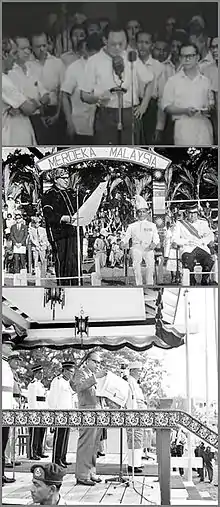
The Depression of the 1930s, followed by the outbreak of the Sino-Japanese War, had the effect of ending Chinese emigration to Malaya. This stabilised the demographic situation and ended the prospect of the Malays becoming a minority in their own country. At the time of independence in 1957, Malays comprised 55% of the population, Chinese 35% and Indians 10%. This balance was altered by the inclusion of the majority-Chinese Singapore, upsetting many Malays.[25] The federation increased the Chinese proportion to close to 40%. Both UMNO and the MCA were nervous about the possible appeal of Lee's People's Action Party (then seen as a radical socialist party) to voters in Malaya, and tried to organise a party in Singapore to challenge Lee's position there. Lee in turn threatened to run PAP candidates in Malaya at the 1964 federal elections, despite an earlier agreement that he would not do so (see PAP-UMNO Relations). Racial tensions intensified as PAP created an opposition alliance aiming for equality between races.[38] This provoked Tunku Abdul Rahman to demand that Singapore withdraw from Malaysia. While the Singaporean leaders attempted to keep Singapore as a part of the Federation, the Malaysian Parliament voted 126–0 on 9 August 1965 in favor of the expulsion of Singapore.[169]
The most vexed issues of independent Malaysia were education and the disparity of economic power among the ethnic communities. The Malays felt unhappy with the wealth of the Chinese community, even after the expulsion of Singapore. Malay political movements emerged based around this.[25] However, since there was no effective opposition party, these issues were contested mainly within the coalition government, which won all but one seat in the first post-independence Malayan Parliament. The two issues were related, since the Chinese advantage in education played a large part in maintaining their control of the economy, which the UMNO leaders were determined to end. The MCA leaders were torn between the need to defend their own community's interests and the need to maintain good relations with UMNO. This produced a crisis in the MCA in 1959, in which a more assertive leadership under Lim Chong Eu defied UMNO over the education issue, only to be forced to back down when Tunku Abdul Rahman threatened to break up the coalition.
The Education Act of 1961 put UMNO's victory on the education issue into legislative form. Henceforward Malay and English would be the only teaching languages in secondary schools, and state primary schools would teach in Malay only. Although the Chinese and Indian communities could maintain their own Chinese and Tamil-language primary schools, all their students were required to learn Malay, and to study an agreed "Malayan curriculum". Most importantly, the entry exam to the University of Malaya (which moved from Singapore to Kuala Lumpur in 1963) would be conducted in Malay, even though most teaching at the university was in English until the 1970s. This had the effect of excluding many Chinese students. At the same time, Malay schools were heavily subsidised, and Malays were given preferential treatment. This obvious defeat for the MCA greatly weakened its support in the Chinese community.
As in education, the UMNO government's unspoken agenda in the field of economic development aimed to shift economic power away from the Chinese and towards the Malays. The two Malayan Plans and the First Malaysian Plan (1966–1970) directed resources heavily into developments that would benefit the rural Malay community, such as village schools, rural roads, clinics, and irrigation projects. Several agencies were set up to enable Malay smallholders to upgrade their production and to increase their incomes. The Federal Land Development Authority (FELDA) helped many Malays to buy farms or to upgrade ones they already owned. The state also provided a range of incentives and low-interest loans to help Malays start businesses, and government tendering systematically favoured Malay companies, leading many Chinese-owned businesses to "Malayanise" their management. All this certainly tended to reduce to gap between Chinese and Malay standards of living, although some argued that this would have happened anyway as Malaysia's trade and general prosperity increased.
Crisis of 1969 and Communist insurgency
The collaboration of the MCA and the MIC in these policies weakened their hold on the Chinese and Indian electorates. At the same time, the effects of the government's affirmative action policies of the 1950s and 1960s had been to create a discontented class of educated but underemployed Malays. This was a dangerous combination, and led to the formation of a new party, the Malaysian People's Movement (Gerakan Rakyat Malaysia) in 1968. Gerakan was a deliberately non-communal party, bringing in Malay trade unionists and intellectuals as well as Chinese and Indian leaders. At the same time, an Islamist party, the Islamic Party of Malaysia (PAS) and a Democratic socialist party, the Democratic Action Party (DAP), gained increasing support, at the expense of UMNO and the MCA respectively.[25]
Following the end of the Malayan Emergency in 1960, the predominantly ethnic Chinese Malayan National Liberation Army, armed wing of the Malayan Communist Party, had retreated to the Malaysian-Thailand border where it had regrouped and retrained for future offensives against the Malaysian government. The insurgency officially began when the MCP ambushed security forces in Kroh–Betong, in the northern part of Peninsular Malaysia, on 17 June 1968. Instead of declaring a "state of emergency" as the British had done previously, the Malaysian government responded to the insurgency by introducing several policy initiatives including the Security and Development Program (KESBAN), Rukun Tetangga (Neighbourhood Watch), and the RELA Corps (People's Volunteer Group).
At the May 1969 federal elections, the UMNO-MCA-MIC Alliance polled only 48% of the vote, although it retained a majority in the legislature. The MCA lost most of the Chinese-majority seats to Gerakan or DAP candidates. The victorious opposition celebrated by holding a motorcade on the main streets of Kuala Lumpur with supporters holding up brooms as a signal of its intention to make sweeping changes. Fear of what the changes might mean for them (as much of the country's businesses were Chinese-owned), a Malay backlash resulted, leading rapidly to riots and inter-communal violence in which about 6,000 Chinese homes and businesses were burned and at least 184 people were killed, although Western diplomatic sources at the time suggested a toll of close to 600, with most of the victims are Chinese.[170][171] The government declared a state of emergency, and a National Operations Council, headed by Deputy Prime Minister Tun Abdul Razak, took power from the government of Tunku Abdul Rahman, who, in September 1970, was forced to retire in favour of Abdul Razak. It consisted of nine members, mostly Malay, and wielded full political and military power.[25]
Using the Emergency-era Internal Security Act (ISA), the new government suspended Parliament and political parties, imposed press censorship and placed severe restrictions on political activity. The ISA gave the government power to intern any person indefinitely without trial. These powers were widely used to silence the government's critics, and have never been repealed. The Constitution was changed to make illegal any criticism, even in Parliament, of the Malaysian monarchy, the special position of Malays in the country, or the status of Malay as the national language.
In 1971 Parliament reconvened, and a new government coalition, the National Front (Barisan Nasional), was formed in 1973 to replace the Alliance party.[25] The coalition consisted of UMNO, the MCA, the MIC, Gerakan, PPP, and regional parties in Sabah and Sarawak. The PAS also joined the Front but was expelled in 1977. The DAP was left outside as the only significant opposition party. Abdul Razak held office until his death in 1976. He was succeeded by Datuk Hussein Onn, the son of UMNO's founder Onn Jaafar, and then by Tun Mahathir Mohamad, who had been Education Minister since 1981, and who held power for 22 years. During these years policies were put in place which led to the rapid transformation of Malaysia's economy and society, such as the controversial New Economic Policy, which was intended to increase proportionally the share of the economic "pie" of the bumiputras as compared to other ethnic groups—was launched by Prime Minister Tun Abdul Razak. Malaysia has since maintained a delicate ethno-political balance, with a system of government that has attempted to combine overall economic development with political and economic policies that promote equitable participation of all races.[172]
Modern Malaysia
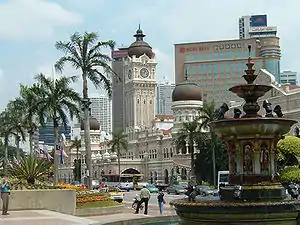
In 1970 three-quarters of Malaysians living below the poverty line were Malays, the majority of Malays were still rural workers, and Malays were still largely excluded from the modern economy. The government's response was the New Economic Policy of 1971, which was to be implemented through a series of four five-year plans from 1971 to 1990. The plan had two objectives: the elimination of poverty, particularly rural poverty, and the elimination of the identification between race and prosperity.[25] This latter policy was understood to mean a decisive shift in economic power from the Chinese to the Malays, who until then made up only 5% of the professional class.[25]
Poverty was tackled through an agricultural policy which resettled 250,000 Malays on newly cleared farmland, more investment in rural infrastructure, and the creation of free trade zones in rural areas to create new manufacturing jobs. Little was done to improve the living standards of the low-paid workers in plantation agriculture, although this group steadily declined as a proportion of the workforce. By 1990 the poorest parts of Malaysia were rural Sabah and Sarawak, which lagged significantly behind the rest of the country. During the 1970s and '80s rural poverty did decline, particularly in the Malayan Peninsula, but critics of the government's policy contend that this was mainly due to the growth of overall national prosperity (due in large part to the discovery of important oil and gas reserves) and migration of rural people to the cities rather than to state intervention. These years saw rapid growth in Malaysian cities, particularly Kuala Lumpur, which became a magnet for immigration both from rural Malaya and from poorer neighbours such as Indonesia, Bangladesh, Thailand and the Philippines. Urban poverty became a problem for the first time, with shanty towns growing up around the cities.
The second arm of government policy, driven mainly by Mahathir first as Education Minister and then as Prime Minister, was the transfer of economic power to the Malays. Mahathir greatly expanded the number of secondary schools and universities throughout the country, and enforced the policy of teaching in Malay rather than English. This had the effect of creating a large new Malay professional class. It also created an unofficial barrier against Chinese access to higher education, since few Chinese are sufficiently fluent in Malay to study at Malay-language universities. Chinese families therefore sent their children to universities in Singapore, Australia, Britain or the United States – by 2000, for example, 60,000 Malaysians held degrees from Australian universities. This had the unintended consequence of exposing large numbers of Malaysians to life in Western countries, creating a new source of discontent. Mahathir also greatly expanded educational opportunities for Malay women – by 2000 half of all university students were women.
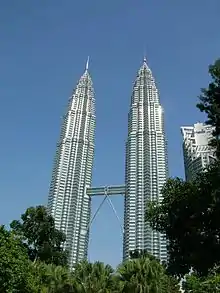
To find jobs for all these new Malay graduates, the government created several agencies for intervention in the economy. The most important of these were PERNAS (National Corporation Ltd.), PETRONAS (National Petroleum Ltd.), and HICOM (Heavy Industry Corporation of Malaysia), which not only directly employed many Malays but also invested in growing areas of the economy to create new technical and administrative jobs which were preferentially allocated to Malays. As a result, the share of Malay equity in the economy rose from 1.5% in 1969 to 20.3% in 1990, and the percentage of businesses of all kinds owned by Malays rose from 39 percent to 68 percent. This latter figure was deceptive because many businesses that appeared to be Malay-owned were still indirectly controlled by Chinese, but there is no doubt that the Malay share of the economy considerably increased. The Chinese remained disproportionately powerful in Malaysian economic life, but by 2000 the distinction between Chinese and Malay business was fading as many new corporations, particularly in growth sectors such as information technology, were owned and managed by people from both ethnic groups.
Malaysia's rapid economic progress since 1970, which was only temporarily disrupted by the Asian financial crisis of 1997, has not been matched by change in Malaysian politics. The repressive measures passed in 1970 remain in place. Malaysia has had regular elections since 1974, and although campaigning is reasonably free at election time, it is in effect a one-party state, with the UMNO-controlled National Front usually winning nearly all the seats, while the DAP wins some Chinese urban seats and the PAS some rural Malay ones. Since the DAP and the PAS have diametrically opposed policies, they have been unable to form an effective opposition coalition. There is almost no criticism of the government in the media and public protest remains severely restricted. The ISA continues to be used to silence dissidents, and the members of the UMNO youth movement are deployed to physically intimidate opponents.
Mahathir administration
.jpg.webp)
The restoration of democracy after the 1969 crisis caused disputes in the UMNO, a struggle of power which increased after the death of Tun Abdul Razak. The ailing Datuk Hussein Bin Onn replaced him, but the fight for control shifted to appointing the deputy prime minister. Mahathir Mohamad was chosen, an advocate of Bumiputra who also tried to benefit the other ethnic communities.[25]
Under the premiership of Mahathir Mohamad, Malaysia experienced economic growth from the 1980s, a 1985–86 property market depression,[173] and returned to growth through to the mid-1990s.[174] Mahathir increased privatisation and introduced the New Development Policy (NDP), designed to increase economic wealth for all Malaysians, rather than just Malays.[25] The period saw a shift from an agriculture-based economy to one based on manufacturing and industry in areas such as computers and consumer electronics. It was during this period, too, that the physical landscape of Malaysia changed with the emergence of numerous mega-projects. Notable amongst these projects were the construction of the Petronas Twin Towers (at the time the tallest building in the world, and, as of 2016, still the tallest twin building), Kuala Lumpur International Airport (KLIA), the North–South Expressway, the Sepang International Circuit, the Multimedia Super Corridor (MSC), the Bakun hydroelectric dam, and Putrajaya, the new federal administrative capital.
Under Mahathir Mohamad's long Prime Ministership (1981–2003), Malaysia's political culture became increasingly centralised and authoritarian, due to Mahathir's belief that the multiethnic Malaysia could only remain stable through controlled democracy. In 1986–87, he faced leadership challenges among his own party. There were also attacks by the government on several non-governmental organisations (NGO) which were critical of various government policies.[175] There were also issues such the questioning by MCA's Lee Kim Sai over the use of the term pendatang (immigrants) that was seen as challenging Malay's bumiputra status,[176] as well as rumours of forced conversion to or from Islam.[177] Mahathir initiated a crackdown on opposition dissidents with the use of the Internal Security Act named Operation Lalang. The Internal Security Act was invoked in October 1987 arresting 106 people, including opposition leaders. The head of the judiciary and five members of the supreme court who had questioned his use of the ISA were also arrested, and a clampdown on Malaysia's press occurred.[25]
This culminated in the dismissal and imprisonment on unsubstantiated charges of the Deputy Prime Minister, Anwar Ibrahim, in 1997 after an internal dispute within the government. The complicity of the judiciary in this piece of persecution was seen as a particularly clear sign of the decline of Malaysian democracy. The Anwar affair led to the formation of a new party, the People's Justice Party, or Keadilan, led by Anwar's wife, Wan Azizah Wan Ismail. At the 1999 elections Keadilan formed a coalition with the DAP and the PAS known as the Alternative Front (Barisan Alternatif). The result of this was that the PAS won a number of Malay seats from UMNO, but many Chinese voters disapproved of this unnatural alliance with the Islamist PAS, causing the DAP to lose many of its seats to the MCA, including that of its veteran leader, Lim Kit Siang. Wan Azizah won her husband's former constituency in Penang but otherwise, Keadilan made little impact.
In the late 1990s, Malaysia was shaken by the Asian financial crisis, which damaged Malaysia's assembly line-based economy. Mahathir combated it initially with IMF approved policies. However, the devaluation of the Ringgit and the deepening recession caused him to create his own programme, based on protecting Malaysia from foreign investors and reinvigorating the economy through construction projects and the lowering of interest rates. The policies caused Malaysia's economy to rebound by 2002, but brought disagreement between Mahathir and his deputy, Anwar Ibrahim, who backed the IMF policies.[25] This led to the sacking of the Anwar, causing political unrest.[178] Anwar was arrested and banned from politics on what are considered trumped-up charges.[25] In 2003, Mahathir, Malaysia's longest-serving prime minister, voluntarily retired in favour of his new deputy, Abdullah Ahmad Badawi.[25] In November 2007 two anti-government rallies occurred, precipitated by allegations of corruption and discrepancies in the election system that heavily favoured the ruling political coalition, National Front (Barisan Nasional), which has been in power since Malaya achieved independence.[179]
Abdullah administration
Dato Seri Abdullah Ahmad Badawi freed Anwar,[25] which was seen as a portent of a mild liberalisation. At the 2004 election, the National Front led by Abdullah had a massive victory,[25] virtually wiping out the PAS and Keadilan, although the DAP recovered the seats it had lost in 1999. This victory was seen as the result mainly of Abdullah's personal popularity and the strong recovery of Malaysia's economy, which has lifted the living standards of many Malaysians to almost first world standards, coupled with an ineffective opposition. The government's objective is for Malaysia to become a fully developed country by 2020 as expressed in Wawasan 2020. It leaves unanswered, however, the question of when and how Malaysia will acquire a first world political system (a multi-party democracy, a free press, an independent judiciary and the restoration of civil and political liberties) to go with its new economic maturity.
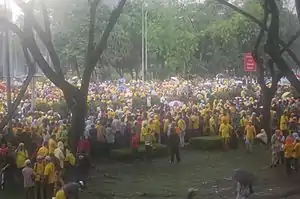
In November 2007, Malaysia was rocked by two anti-government rallies. The 2007 Bersih Rally which was attended by 40,000 people was held in Kuala Lumpur on 10 November 2007, to campaign for electoral reform. It was precipitated by allegations of corruption and discrepancies in the Malaysian election system that heavily favour the ruling political party, Barisan Nasional, which has been in power since Malaysia achieved its independence in 1957.[180] Another rally was held on 25 November 2007, in Kuala Lumpur led by HINDRAF. The rally organiser, the Hindu Rights Action Force, had called the protest over alleged discriminatory policies favouring ethnic Malays. The crowd was estimated to be between 5,000 and 30,000.[181] In both cases the government and police tried to prevent the gatherings from taking place.
On 16 October 2008, HINDRAF was banned when the government labelled the organisation as "a threat to national security".[182]
Najib administration
Najib Razak entered office as Prime Minister with a sharp focus on domestic economic issues and political reform. On his first day as Prime Minister, Najib announced as his first actions the removal of bans on two opposition newspapers, Suara Keadilan and Harakahdaily, run by the opposition leader Datuk Seri Anwar Ibrahim-led People's Justice Party and the Pan Islamic Party, respectively, and the release of 13 people held under the Internal Security Act. Among the released detainees were two ethnic Indian activists who were arrested in December 2007 for leading an anti-government campaign, three foreigners and eight suspected Islamic militants. Najib also pledged to conduct a comprehensive review of the much-criticised law which allows for indefinite detention without trial. In the speech, he emphasised his commitment to tackling poverty, restructuring Malaysian society, expanding access to quality education for all, and promoting renewed "passion for public service".[183] He also deferred and abandoned the digital television transition plan of all free-to-air broadcasters such as Radio Televisyen Malaysia.
Malaysia Day, celebrating the formation of Malaysia on 16 September 1963, was declared a public holiday in 2010 in complement to the existing 31 August celebration of Hari Merdeka.[184]
In 2015, there was an exposé alleging that MYR 2.672 billion (US$700 million) had been channelled from 1Malaysia Development Berhad into Najib's personal bank accounts, triggering widespread calls from most Malaysians including the opposition parties for his resignation.[185][186][187]
In September 2016, Mahathir submitted a request to the King requesting Najib be dismissed, although no action was taken on this.[188]
Second Mahathir administration
Tun Dr Mahathir Mohamad, who left UMNO in 2016 and formed his own political party, the Malaysian United Indigenous Party which teamed up with three other political parties to form Pakatan Harapan, was sworn in as the Prime Minister of Malaysia after winning the election on 10 May 2018. He defeated Najib Razak who led Barisan Nasional that had previously ruled Malaysia for 61 years since 1957. Najib's defeat was because of the ongoing 1Malaysia Development Berhad scandal that has started since 2015, the introduction of Goods and Services Tax (Malaysia) of 6%, high cost of living and his publicly extreme criticism against Mahathir Mohamad. [189]
The unpopular tax was reduced to 0% on 1 June 2018. Government of Malaysia under Mahathir tabled for first reading Bill to repeal GST in Parliament on 31 July 2018 (Dewan Rakyat). GST was successfully replaced with Sales Tax and Service Tax starting 1 September 2018.[190][191]
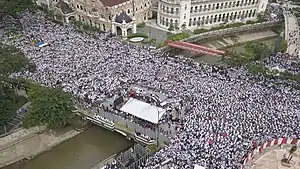
On 28 September 2018, Mahathir Mohamad addressed the United Nations General Assembly that his government would promise to ratify the ICERD. However, later on 23 November 2018, the Pakatan Harapan government decided not to accede the ICERD after weeks of receiving racially and religiously charged protest against the convention, especially from Bumiputras.[192]
Muhyiddin administration
On 29 February 2020, a week after the country was thrown into a political crisis, Muhyiddin Yassin was appointed Prime Minister by the king, following the abrupt resignation of Mahathir Mohamad five days before.[193] He is the first person appointed to the position while holding both a parliamentary and state seat at the same time. During his administration, COVID-19 spread throughout the nation. In response, Muhyiddin implemented the Malaysian movement control order (MCO) on 16 March 2020 to prevent the disease from spreading throughout Malaysia.[194]
In mid-January 2021, King Abdullah of Pahang declared a national state of emergency until at least 1 August in response to rising COVID-19 cases and political infighting within Prime Minister Muhyiddin's Perikatan Nasional government. Under this state of emergency, parliament and elections was suspended while the Malaysian government was empowered to introduce laws without approval.[195][196]
See also
Notes
- Major ports in their respective regions included Palembang on the Malaccan Strait, Calicut on the Malabar coast, and Mombasa on the Swahili Coast[60]
References
- Imago Mvndi. Brill Archive. 1958.
- Annual Report on the Federation of Malaya: 1951 in C.C. Chin and Karl Hack, Dialogues with Chin Peng pp. 380, 81.
- "Road to Independence". US Government. Retrieved 3 August 2013.
- Jomo, K. S. (2005). Malaysia's New Economic Policy and 'National Unity. Palgrave Macmillan. pp. 182–214. doi:10.1057/9780230554986_8. ISBN 978-1-349-52546-1. Retrieved 24 September 2020.
- Department of National Heritage, Ministry of Information Communications and Culture Malaysia (January 2011). "Archaeological Heritage of Lenggong Valley: Nomination Dossier for Inscription on the UNESCO World Heritage List" (PDF). World Heritage Committee, UNESCO. Retrieved 8 October 2015.
- "History of the Great Cave of Niah". ABC Online. Retrieved 6 January 2014.
- "Niah National Park – Early Human settlements". Sarawak Forestry. Archived from the original on 18 February 2015. Retrieved 23 March 2015.
- "History of the Great Cave of Niah". Australian Broadcasting Corporation. Archived from the original on 22 November 2014. Retrieved 23 March 2015.
- "Niah Cave". humanorigins.si.edu. Smithsonian National Museum of Natural History. Archived from the original on 22 November 2013. Retrieved 23 March 2015.
- Faulkner, Neil (7 November 2003). Niah Cave, Sarawak, Borneo. Current World Archaeology Issue 2. Archived from the original on 23 March 2015. Retrieved 23 March 2015.
- Hirst, K. Kris. "Niah Cave (Borneo, Malaysia) – Anatomically modern humans in Borneo". about.com. Archived from the original on 5 November 2013. Retrieved 23 March 2015.
- "Niah National Park, Miri". Sarawak Tourism Board. Archived from the original on 26 December 2015. Retrieved 26 December 2015.
- "Genetic 'map' of Asia's diversity". BBC News. 11 December 2009.
- Liz Price (17 March 2007). "Tracing back Malaysia's stone-age man in Lenggong". The Brunei Times. Archived from the original on 15 October 2015. Retrieved 8 October 2015.
- Davies, Norman (7 December 2017). Beneath Another Sky: A Global Journey into History. Penguin UK. ISBN 978-1-84614-832-3.
- Fix, Alan G. (June 1995). "Malayan Paleosociology: Implications for Patterns of Genetic Variation among the Orang Asli". American Anthropologist. New Series. 97 (2): 313–323. doi:10.1525/aa.1995.97.2.02a00090. JSTOR 681964.
- "TED Cast Study: Taman Negara Rain Forest Park and Tourism". August 1999. Archived from the original on 9 June 2010. Retrieved 8 July 2010.
- "Phylogeography and Ethnogenesis of Aboriginal Southeast Asians". http://mbe.oxfordjournals.org: Oxford University Press. Retrieved 6 July 2010.
- "World Directory of Minorities and Indigenous Peoples – Malaysia : Orang Asli". Ref World (UNHCR). 2008. Retrieved 8 October 2015.
- Michel Jacq-Hergoualc'h (January 2002). The Malay Peninsula: Crossroads of the Maritime Silk-Road (100 Bc-1300 Ad). BRILL. pp. 24–. ISBN 90-04-11973-6.
- R.H von Geldern, J.H.C Kern, J.R Foster, J.R Logen, Slametmuljana and Asmah Haji Omar.
A history of Malaya and her neighbours – Page 21 – by Francis Joseph Moorhead, published by Longmans of Malaysia, 1965
India and ancient Malaya (from the earliest times to circa A.D. 1400) – Page 3 – by D. Devahuti, Published by D. Moore for Eastern Universities Press, 1965
The making of modern Malaya: a history from earliest times to independence – Page 5 – by N. J. Ryan, Oxford University Press, 1965
The cultural heritage of Malaya – Page 2 – by N. J. Ryan published by Longman Malaysia, 1971
A history of Malaysia and Singapore – Page 5 – by N. J. Ryan published by Oxford University Press, 1976
"How the dominoes fell": Southeast Asia in perspective – Page 7 – by Mae H. Esterline, Hamilton Press, 1986
A design guide of public parks in Malaysia – Page 38 – by Jamil Abu Bakar published by Penerbit UTM, 2002, ISBN 983-52-0274-5, ISBN 978-983-52-0274-2
An introduction to the Malaysian legal system – Page 1 – by Min Aun Wu, Heinemann Educational Books (Asia), 1975
A short history of Malaysia – Page 22 – by Harry Miller published by F.A. Praeger, 1966
Malaya and its history – Page 14 – by Sir Richard Olaf Winstedt published by Hutchinson University Library, 1962
Southeast Asia, past & present – Page 10 – by D. R. SarDesai published by Westview Press, 1994
Malaya – Page 17 – by Norton Sydney Ginsburg, Chester F. Roberts published by University of Washington Press, 1958
Asia: a social study – Page 43 – by David Tulloch published by Angus and Robertson, 1969
Area handbook on Malaya University of Chicago, Chester F. Roberts, Bettyann Carner published by University of Chicago for the Human Relations Area Files, 1955
Thailand into the 80's – Page 12 – by Samnak Nāyok Ratthamontrī published by the Office of the Prime Minister, Kingdom of Thailand, 1979
Man in Malaya – Page 22 – by B. W. Hodder published by Greenwood Press, 1973
The modern anthropology of South-East Asia: an introduction, Volume 1 of The modern anthropology of South-East Asia, RoutledgeCurzon Research on Southeast Asia Series – Page 54 – by Victor T. King, William D. Wilder published by Routledge, 2003, ISBN 0-415-29751-6, ISBN 978-0-415-29751-6
Journal of the Malaysian Branch of the Royal Asiatic Society – Page 17 – by Royal Asiatic Society of Great Britain and Ireland. Malaysian Branch, Singapore, 1936
Malay and Indonesian leadership in perspective – Page 9 – by Ahmad Kamar 1984
The Malay peoples of Malaysia and their languages – Page 36 – by Asmah Haji Omar published by Dewan Bahasa dan Pustaka, Kementerian Pelajaran Malaysia, 1983
Encyclopedia of world cultures Volume 5 – Page 174 – by David Levinson – History – 1993 published by G.K. Hall, 1993
Indigenous peoples of Asia – Page 274 – by Robert Harrison Barnes, Andrew Gray, Benedict Kingsbury published by the Association for Asian Studies, 1995
Peoples of the Earth: Indonesia, Philippines and Malaysia edited by Edward Evan Evans-Pritchard published by Danbury Press, 1973
American anthropologist Vol 60 – Page 1228 – by American Anthropological Association, Anthropological Society of Washington (Washington, D.C.), American Ethnological Society, 1958
Encyclopaedia of Southeast Asia (set of 5 Vols.) – Page 4 – by Brajendra Kumar published by Akansha Publishing House, 2006, ISBN 81-8370-073-X, ISBN 978-81-8370-073-3 - "Phylogeography and Ethnogenesis of Aboriginal Southeast Asians". Oxford Journals. Retrieved 11 November 2008.
- Anthony Milner (25 March 2011). The Malays. John Wiley & Sons. pp. 49–. ISBN 978-1-4443-9166-4.
- Kulke, Hermann (2004). A history of India. Rothermund, Dietmar 1933– (4th ed.). New York: Routledge. ISBN 0203391268. OCLC 57054139.
- World and Its Peoples: Eastern and Southern Asia. Marshall Cavendish. 2007. ISBN 978-0-7614-7642-9.
- History of Humanity: From the seventh century B.C. to the seventh century A.D. by Sigfried J. de Laet p.395
- Braddell, Roland (December 1937). "An Introduction to the Study of Ancient Times in the Malay Peninsula and the Straits of Malacca". Journal of the Malayan Branch of the Royal Asiatic Society. 15 (3 (129)): 64–126. JSTOR 41559897.
- ASEAN Member: Malaysia Retrieved 29 May 2008.
- Derek Heng (15 November 2009). Sino–Malay Trade and Diplomacy from the Tenth through the Fourteenth Century. Ohio University Press. pp. 39–. ISBN 978-0-89680-475-3.
- Gernet, Jacques (1996). A History of Chinese Civilization. Cambridge University Press. p. 127. ISBN 978-0-521-49781-7.
- Ishtiaq Ahmed; Professor Emeritus of Political Science Ishtiaq Ahmed (4 May 2011). The Politics of Religion in South and Southeast Asia. Taylor & Francis. pp. 129–. ISBN 978-1-136-72703-0.
- Stephen Adolphe Wurm; Peter Mühlhäusler; Darrell T. Tryon (1996). Atlas of Languages of Intercultural Communication in the Pacific, Asia, and the Americas. Walter de Gruyter. ISBN 978-3-11-013417-9.
- S. Durai Raja Singam Printed by Liang Khoo Printing Co., 1962 -Language Arts & Disciplines −253 pages
- Research on the Early Malay Doctors 1900–1957 Malaya and Singapore, By Faridah Abdul Rashid
- Neutron radiography: proceedings of the second world conference, Paris, France, June 16–20, 1986 John Penrose Barton, Commission of the European Communities, D. Reidel, 1987 -928 pages
- Wheatley, P. (1 January 1955). "The Golden Chersonese". Transactions and Papers (Institute of British Geographers) (21): 61–78. doi:10.2307/621273. JSTOR 621273.
- "Malaysia". State.gov. 14 July 2010. Retrieved 14 September 2010.
- Barbara Watson Andaya; Leonard Y. Andaya (15 September 1984). A History of Malaysia. Palgrave Macmillan. ISBN 978-0-312-38121-9.
- Power and Plenty: Trade, War, and the World Economy in the Second Millennium by Ronald Findlay, Kevin H. O'Rourke p.67
- History of Asia by B. V. Rao (2005), p. 211
- Singapore in Global History by Derek Thiam Soon Heng, Syed Muhd Khairudin Aljunied p.40
- History Without Borders: The Making of an Asian World Region, 1000–1800 by Geoffrey C. Gunn p.43
- Nagapattinam to Suvarnadwipa: Reflections on the Chola Naval Expeditions to Southeast Asia by Hermann Kulke, K Kesavapany, Vijay Sakhuja p.71
- Buddhism, Diplomacy, and Trade: The Realignment of Sino-Indian Relations by Tansen Sen p.226
- Aryatarangini, the Saga of the Indo-Aryans, by A. Kalyanaraman p.158
- India and Malaya Through the Ages: by S. Durai Raja Singam
- Zheng, Dekun (1 January 1982). Studies in Chinese Archeology. The Chinese University Press. pp. 49, 50. ISBN 978-962-201-261-5. Retrieved 29 December 2015.
In case of Santubong, its association with T'ang and Sung porcelain would necessary provide a date of about 8th – 13th century A.D.
- "Archeology". Sarawak Muzium Department. Archived from the original on 12 October 2015. Retrieved 28 December 2015.
- Sabrizain, p. The Tuah Legend
- Coedès, George (1968). Walter F. Vella (ed.). The Indianized States of Southeast Asia. trans.Susan Brown Cowing. University of Hawaii Press. ISBN 978-0-8248-0368-1.
- Alexanderll, James (September 2006). Malaysia Brunei & Singapore. New Holland Publishers. p. 8. ISBN 9781860113093.
- "South and Southeast Asia, 500 – 1500". The Encyclopedia of World History. 1. Houghton Mifflin Harcourt. 2001. p. 138.
- C. Edmund Bosworth (26 December 2007). Historic Cities of the Islamic World. BRILL. pp. 314–. ISBN 978-90-474-2383-6.
- Kent, Jonathan (3 March 2005). "Chinese diaspora: Malaysia". BBC News. Retrieved 21 September 2010.
- Zheng He's Voyages Down the Western Seas. 五洲传播出版社. 2005. pp. 58–. ISBN 978-7-5085-0708-8.
- Wade 2005, p.
- Lim SK (1 November 2011). Asia Civilizations: Ancient to 1800 AD. Asiapac Books Pte Ltd. pp. 153–. ISBN 978-981-229-594-1.
- Wong Hui Shin (20 June 2012). Sunshine Little Kitchen. AuthorHouse. pp. 49–. ISBN 978-1-4772-1460-2.
- Donald B. Freeman (17 April 2003). Straits of Malacca: Gateway Or Gauntlet?. McGill-Queen's Press – MQUP. pp. 127–. ISBN 978-0-7735-2515-3.
- Sen, Tansen (2016). "The Impact of Zheng He's Expeditions on Indian Ocean Interactions". Bulletin of the School of Oriental and African Studies. 79 (3): 615–621. doi:10.1017/S0041977X16001038.
- Jin, Shaoqing (2005). Office of the People's Government of Fujian Province (ed.). Zheng He's voyages down the western seas. Fujian, China: China Intercontinental Press. p. 58. ISBN 978-7-5085-0708-8. Retrieved 2 August 2009.
- Nicole Revel (17 September 2013). Songs of Memory in Islands of Southeast Asia. Cambridge Scholars Publishing. pp. 296–. ISBN 978-1-4438-5280-7.
- "Sultanate of Malacca". Encyclopædia Britannica. 2011. Retrieved 8 October 2015.
- "Demak". Encyclopædia Britannica. 2011. Retrieved 8 October 2015.
- Anthony Reid, "Islamization and Christianization in Southeast Asia: the Critical Phase, 1550–1650". In Southeast Asia in the Early Modern Era: Trade, Power, and Belief, ed. Anthony Reid. Ithaca, NY: Cornell University Press, pp.151–79
- P. M. Holt; Ann K. S. Lambton; Bernard Lewis (21 April 1977). The Cambridge History of Islam. Cambridge University Press. pp. 129–. ISBN 978-0-521-29137-8.
- Barbara Watson Andaya; Leonard Y. Andaya (19 February 2015). A History of Early Modern Southeast Asia, 1400-1830. Cambridge University Press. pp. 159–. ISBN 978-0-521-88992-6.
- Spencer C. Tucker (23 December 2009). A Global Chronology of Conflict: From the Ancient World to the Modern Middle East: From the Ancient World to the Modern Middle East. ABC-CLIO. pp. 581–. ISBN 978-1-85109-672-5.
- Eur (2002). The Far East and Australasia 2003. Psychology Press. pp. 763–. ISBN 978-1-85743-133-9.
- Winstedt, R. O. (1992). A history of Johore, 1365–1895. Kuala Lumpur: Malaysian Branch of the Royal Asiatic Society. p. 36. ISBN 983-99614-6-2.
- Borschberg, Peter. The Singapore and Melaka Straits: Violence, Security and Diplomacy in the 17th Century.
- Borschberg (2011), pp. 215–223
- Borschberg (2010b), pp. 97–100
- M.C. Ricklefs, Bruce Lockhart, Albert Lau, Portia Reyes, Maitrii Aung-Thwin (19 November 2010). A New History of Southeast Asia. Palgrave Macmillan. p. 150. ISBN 9781137015549.CS1 maint: uses authors parameter (link)
- Tan Ding Eing (1978). A Portrait of Malaysia and Singapore. Oxford University Press. p. 22. ISBN 978-0195807226.
- Jim Baker (15 July 2008). Crossroads (2nd Edn): A Popular History of Malaysia and Singapore. Marshall Cavendish International (Asia) Pte Ltd. pp. 64–65. ISBN 978-9814516020.
- "History", Embassy of Malaysia, Seoul Archived 30 April 2008 at the Wayback Machine
- Commercial Relations of the United States with Foreign Countries During the Years ... U.S. Government Printing Office. 1904. pp. 486–488.
- Alan Teh Leam Seng (8 July 2018). "The story behind Malaysia's second oldest sultanate uncovered". New Straits Times. Retrieved 7 September 2019.
- "Senarai Sultan Perak" [List of Sultans of Perak] (in Malay). The Administration Office of His Majesty the Sultan of Perak. Archived from the original on 7 September 2019. Retrieved 7 September 2019.
- "Tok Temong (Keramat Tok Temong)" (in Malay). The Administration Office of His Majesty the Sultan of Perak. Archived from the original on 15 October 2019. Retrieved 15 October 2019.
- Paulo Jorge de Sousa Pinto (2012). The Portuguese and the Straits of Melaka, 1575–1619: Power, Trade, and Diplomacy. NUS Press. ISBN 978-967-9948-51-6.
- Mohamad Rashidi Pakri; Nik Haslinda Nik Hussain (2017). Klian Intan: Perlombongan Bijih Timah dan Perkembangan Sosioekonomi (Penerbit USM) [Klian Intan: Tin Mining and Socio-Economic Development (USM Publisher)] (in Malay). Penerbit USM. pp. 35–. ISBN 978-967-461-134-7.
- Barbara Watson Andaya (11 November 1982). History Of Malaysia. Macmillan International Higher Education. pp. 61–117. ISBN 978-1-349-16927-6.
- The Asiatic Journal and Monthly Register for British and Foreign India, China, and Australia. Parbury, Allen, and Company. 1841. pp. 152–.
- Charles Otto Blagden (1925). British Malaya, 1824–67. Methodist Publishing House.
- Duncan Stearn (25 March 2019). Slices of Thai History: From the curious & controversial to the heroic & hardy. Proglen Trading Co., Ltd. pp. 56–. ISBN 978-616-456-012-3.
- Om Prakash (28 June 1998). European Commercial Enterprise in Pre-Colonial India. Cambridge University Press. pp. 235–. ISBN 978-0-521-25758-9.
- Ali Hasymy (1977). 59 [i.e. Limapuluh sembilan] tahun Aceh merdeka di bawah pemerintahan ratu [59 [i.e. Fifty nine] years of Aceh independence under the rule of queen] (in Indonesian). Bulan Bintang.
- Sher Banu. A Latiff Khan (27 April 2018). Sovereign Women in a Muslim Kingdom. Flipside Digital Content Company Inc. pp. 106–. ISBN 978-981-325-005-5.
- "Kota Belanda, Pulau Pangkor". National Archives of Malaysia. Archived from the original on 11 February 2015. Retrieved 12 September 2019.
- Sher Banu. A Latiff Khan (2009). "Rule Behind the Silk Curtain: The Sultanahs of Aceh 1641–1699" (PDF). Centre for Editing Lives and Letters (Cell) Queen Mary University of London. Archived from the original (PDF) on 12 September 2019. Retrieved 12 September 2019 – via CORE.
- Journal of the Malaysian Branch of the Royal Asiatic Society. The Branch. 1936.
- "Sultan Muzaffar Shah III Of Perak Signed The Treaty Of Dutch Monopoly Over Trading Of Tin In Perak". National Archives of Malaysia. 25 June 1747. Archived from the original on 15 September 2019. Retrieved 15 September 2019.
- Linehan 1973, p. 31
- Ahmad Sarji Abdul Hamid 2011, p. 80
- Ahmad Sarji Abdul Hamid 2011, p. 81
- Bungo, N.; Hussin, Nordin; Omar, Rahilah; Bidin, Aishah (September 2012). "Early settlements of the minangkabaus community in Selangor" (PDF). Pertanika Journal of Social Science and Humanities. 20 (3): 931–947.
- Jim Baker (15 July 2008). Crossroads (2nd Edn): A Popular History of Malaysia and Singapore. Marshall Cavendish International (Asia) Pte Ltd. p. 71. ISBN 978-9814516020.
- Tan Ding Eing (1975). A Portrait of Malaysia and Singapore. Oxford University Press. p. 74. ISBN 978-0195807226.
- Suyatno 2008.
- Awang Juned 1992.
- Saunders 2013, pp. 23.
- Saunders 2013, pp. 60.
- Herbert & Milner 1989, pp. 99.
- Lea & Milward 2001, pp. 16.
- Hicks 2007, pp. 34.
- Church 2012, pp. 16.
- Eur 2002, pp. 203.
- Abdul Majid 2007, pp. 2.
- Welman 2013, pp. 8.
- Broek, Jan O.M. (1962). "Place Names in 16th and 17th Century Borneo". Imago Mundi. 16 (1): 134. doi:10.1080/03085696208592208. JSTOR 1150309.
Carena (for Carena), deep in the bight, refers to Sarawak, the Kuching area, where there is clear archaeological evidence of an ancient trade center just inland from Santubong.
- Donald F, Lach (15 July 2008). Asia in the Making of Europe, Volume I: The Century of Discovery, Book 1. University of Chicago Press. p. 581. ISBN 978-0-226-46708-5. Retrieved 21 March 2016.
... but Castanheda lists five great seaports that he says were known to the Portuguese. In his transcriptions they are called "Moduro" (Marudu?), "Cerava" (Sarawak?), "Laue" (Lawai), "Tanjapura" (Tanjungpura), and "Borneo" (Brunei) from which the island derives its name.
- Rozan Yunos (28 December 2008). "Sultan Tengah – Sarawak's first Sultan". The Brunei Times. Archived from the original on 3 April 2014. Retrieved 3 April 2014.
- Saunders 2002, pp. 54–60
- Alastair, Morrison (1 January 1993). Fair Land Sarawak: Some Recollections of an Expatriate Official. SEAP Publications. p. 10. ISBN 978-0-87727-712-5. Retrieved 29 October 2015.
- Trudy, Ring; Noelle, Watson; Paul, Schellinger (12 November 2012). Asia and Oceania: International Dictionary of Historic Places. SEAP Publications. p. 497. ISBN 978-0-87727-712-5. Retrieved 29 October 2015.
- B.A., Hussainmiya (2006). "The Brookes and the British North Borneo Company". Brunei – Revival of 1906 – A popular history (PDF). Bandar Seri Begawan: Brunei Press Sdn Bhd. p. 6. ISBN 99917-32-15-2. Archived from the original (PDF) on 2 December 2016. Retrieved 2 December 2016.
- R, Reece. "Empire in Your Backyard – Sir James Brooke". Archived from the original on 17 March 2015. Retrieved 29 October 2015.
- Graham, Saunders (5 November 2013). A History of Brunei. Routledge. pp. 74–77. ISBN 978-1-136-87394-2. Retrieved 24 November 2016.
- James Leasor (1 January 2001). Singapore: The Battle That Changed the World. House of Stratus. pp. 41–. ISBN 978-0-7551-0039-2.
- Alex Middleton (June 2010). "Rajah Brooke and the Victorians" (PDF). The Historical Journal. 53 (2): 381–400. doi:10.1017/S0018246X10000063. ISSN 1469-5103. Retrieved 24 December 2014.
- Suzalina Halid 2015
- Ulrike Freitag, W. G. Clarence-Smith, Hadhrami Traders, Scholars, and Statesmen in the Indian Ocean, 1750s–1960s: 1750s- 1960s, pg 87
- Wood, William A. R. (1 October 2001). A History of Siam (Paperback ed.). Lightning Source Inc. ISBN 1931541108.
- Journal of the Malaysian Branch of the Royal Asiatic Society. The Branch. 2005.
- "The Map Room: South East Asia: Malaya". British Empire. Retrieved 18 September 2010.
- Joshua Samuel Brown (15 September 2010). Singapore. Lonely Planet. pp. 22–. ISBN 978-1-74220-401-7.
- See: "Policy in regard to Malaya and Borneo" (PDF). by the Government of the United Kingdom
- "The Encyclopædia Britannica: a dictionary of arts, sciences, literature and general information". Retrieved 17 October 2010.
- "Johor is brought under British control". National Library Board. 12 May 1914. Archived from the original on 30 June 2015. Retrieved 30 June 2015.
- The New Encyclopaedia Britannica: Macropaedia : Knowledge in depth. Encyclopaedia Britannica. 2003. ISBN 978-0-85229-961-6.
- Peter C. Richards (6 December 1947). "New Flag Over Pacific Paradise". The Sydney Morning Herald. Retrieved 22 October 2015.
- Gullick, J. M. (1967). Malaysia and Its Neighbours, The World studies series. Taylor & Francis. pp. 148–149. ISBN 978-0-7100-4141-8.
- Hays, Jeffrey. "BRITISH IN MALAYSIA". Facts and Details, https://factsanddetails.com/southeast-asia/Malaysia/sub5_4a/entry-3619.html#chapter-5.
- Gullick, J. M. (1967). Malaysia and Its Neighbours, The World studies series. Taylor & Francis. pp. 148–149. ISBN 978-0-7100-4141-8.
- Gullick, J. M. (1967). Malaysia and Its Neighbours, The World studies series. Taylor & Francis. pp. 148–149. ISBN 978-0-7100-4141-8.
- Gullick, J. M. (1967). Malaysia and Its Neighbours, The World studies series. Taylor & Francis. pp. 148–149. ISBN 978-0-7100-4141-8.
- Gullick, J. M. (1967). Malaysia and Its Neighbours, The World studies series. Taylor & Francis. pp. 148–149. ISBN 978-0-7100-4141-8.
- Gullick, J. M. (1967). Malaysia and Its Neighbours, The World studies series. Taylor & Francis. pp. 148–149. ISBN 978-0-7100-4141-8.
- Gullick, J. M. (1967). Malaysia and Its Neighbours, The World studies series. Taylor & Francis. pp. 148–149. ISBN 978-0-7100-4141-8.
- Gullick, J. M. (1967). Malaysia and Its Neighbours, The World studies series. Taylor & Francis. pp. 148–149. ISBN 978-0-7100-4141-8.
- Zainal Abidin bin Abdul Wahid; Khoo, Kay Kim; Muhd Yusof bin Ibrahim; Singh, D.S. Ranjit (1994). Kurikulum Bersepadu Sekolah Menengah Sejarah Tingkatan 2. Dewan Bahasa dan Pustaka. pp. 208–209. ISBN 983-62-1009-1.
- Graham, Brown (February 2005). "The Formation and Management of Political Identities: Indonesia and Malaysia Compared" (PDF). Centre for Research on Inequality, Human Security and Ethnicity, CRISE, University of Oxford. Archived from the original (PDF) on 10 February 2012. Cite journal requires
|journal=(help) - David Koh Wee Hock (2007). Legacies of World War II in South and East Asia. Institute of Southeast Asian Studies. ISBN 978-981-230-468-1.
- Mahathir Mohamad (31 May 1999). "Our Region, Ourselves". TIME. Retrieved 26 October 2010.
- Time magazine (19 May 1952). "MALAYA: Token Citizenship". TIME. Retrieved 26 October 2010.
- "Malaya: Siege's End", Time, New York, 2 May 1960.
- "A New Nation", Time, New York, 9 September 1957
- See:
 Works related to Federation of Malaya Agreement at Wikisource
Works related to Federation of Malaya Agreement at Wikisource - Stockwell, AJ (2004). British documents of the end of empire Series B Volume 8 – "Paper on the future of the Federation of Malaya, Singapore, and Borneo Territories":memorandum by Lee Kuan Yew for the government of the Federation of Malaya (CO1030/973, no E203). University of London: Institute of Commonwealth Studies. p. 108. ISBN 0112905811. Retrieved 27 May 2015.
On 24 Apr Lee Kuan Yew informed Selkirk that on the previous day he had spoken to the Tunku for the first time about the Grand Design.
- JC, Fong (16 September 2011). "Formation of Malaysia". The Borneo Post. Archived from the original on 16 July 2014. Retrieved 27 May 2015.
- "Tunku announces proposal for merger". National Library, Singapore. Retrieved 27 June 2015.
- "Big 'Unity' Plan – Tengku on Closer Ties with S'pore, Borneo, and Brunei". The Straits Times. National Library, Singapore. 28 May 1961. Retrieved 27 June 2015.
- Shuid, Mahdi & Yunus, Mohd. Fauzi (2001). Malaysian Studies, p. 29. Longman. ISBN 983-74-2024-3.
- Shuid & Yunus, pp. 30–31.
- Adam, Ramlah binti, Samuri, Abdul Hakim bin & Fadzil, Muslimin bin (2004). Sejarah Tingkatan 3, p. 207. Dewan Bahasa dan Pustaka. ISBN 983-62-8285-8.
- "Malaysia: Hurray for Harry", Time, New York, 20 September 1963.
- "Malaysia: Fighting the Federation", Time, New York, 21 December 1962.
- Shuid & Yunus, p. 31.
- "Malaysia: Tunku Yes, Sukarno No". TIME. 6 September 1963. Retrieved 17 October 2010.
- "Malaysia: Tunku Yes, Sukarno No", Time, New York, 6 September 1963.
- Philippines, Federation of Malaya, Indonesia (1963). "No 8029: Manila Accord, Declaration and Joint Statement" (PDF). United Nations Treaty Collection. United Nations. Archived from the original (PDF) on 11 October 2010. Retrieved 16 August 2010.CS1 maint: multiple names: authors list (link)
- Mathews, Philip (2–13). Chronicle of Malaysia: Fifty Years of Headline News, 1963–2013. Editions Didier Millet. pp. 40–41. ISBN 978-967-10617-4-9. Check date values in:
|year=(help) - "Philippines' Claim To Sabah". epilipinas. Archived from the original on 7 March 2010. Retrieved 21 June 2010.
- Exchange of notes constituting an agreement relating to the implementation of the Manila Accord of 31 July 1963
- "Proclamation on Singapore". Singapore Attorney-General. Archived from the original on 11 May 2011. Retrieved 27 October 2010.
- "Malaysia: The Art of Dispelling Anxiety". Time magazine. 27 August 1965. Retrieved 26 October 2010.
- "Race War in Malaysia". Time magazine. 23 May 1969. Retrieved 26 October 2010.
- Jomo Kwame Sundaram, UNRISD (1 September 2004). "The New Economic Policy and Interethnic Relations in Malaysia". UNRISD. Retrieved 27 October 2010.
- "Property: A Steep Climb with a Gentle Descent". Euromoney. Euromoney Institutional Investor. August 1992.
- Anthony Spaeth (9 December 1996). "Bound for Glory". Time New York. Archived from the original on 17 March 2009. Retrieved 26 October 2010.
- Saliha Hassan; Meredith Weiss, eds. (2002). Social Movement Malaysia. Routledge. p. 36. ISBN 978-0700716463.
- Lee Kam Hing (2012). Leo Suryadinata (ed.). Southeast Asian Personalities of Chinese Descent: A Biographical Dictionary. Institute of Southeast Asian Studies. p. 516. ISBN 978-9814345217.
- Meredith Leigh Weiss (2005). Protest and Possibilities: Civil Society and Coalitions for Political Change in Malaysia. Stanford University Press. p. 124. ISBN 978-0804752954.
- Anthony Spaeth (14 September 1998). "He's the Boss". Time Asia Hong Kong. Retrieved 26 October 2010.
- Imtiaz Shah Yacob, Imran. "Malaysian Petitioners Defy Police". Asia Sentinel. Retrieved 9 July 2009.
- Imtiaz Shah Yacob, Imran. "Asia Sentinel – Malaysian Petitioners Defy Police". Asia Sentinel. Retrieved 9 July 2009.
- 30,000 Hindraf protesters rally in KL streets, Malaysiakini, 25 November 2007.
- "Malaysia bans Hindraf, says it's a threat to national security". Kuala Lumpur: Press Trust of India. 17 October 2008. Retrieved 21 June 2010.
- "PM Najib's maiden speech: 'One Malaysia. People First. Performance Now.'". The Star. 3 April 2009. Retrieved 24 October 2011.
- Yeng, Ai Chun (19 October 2009). "Malaysia Day now a public holiday, says PM". Retrieved 7 August 2015.
- Wright, Tom; Clark, Simon (2 July 2015). "Investigators Believe Money Flowed to Malaysian Leader Najib's Accounts Amid 1MDB Probe". The Wall Street Journal. Dow Jones & Company. Archived from the original on 3 July 2015. Retrieved 5 July 2015.
- Zaid: Najib's finest hour when he steps down. Free Malaysia Today, 6 July 2015. Retrieved 7 July 2015.
- Najib must resign if he can't dispute claims in WSJ, Sarawak Report, Guan Eng tells reporters Archived 6 January 2016 at the Wayback Machine. The Malaysian Insider, 3 July 2015. Retrieved 7 July 2015.
- "Malaysian democrats pin their hopes on the country's royals". The Economist. 26 January 2017. Retrieved 4 February 2017.
- name="Straits Times">"Mahathir sworn in as Malaysia's 7th prime minister". Singapore Straits Times. 10 May 2018. Retrieved 11 May 2018.
- "Bill to repeal GST tabled in Parliament for first reading". The Star.
- "Malaysia to remove GST for consumers on Jun 1". Channel NewsAsia. Mediacorp. 16 May 2018. Retrieved 26 June 2018.
- Aw, Nigel (24 March 2018). "THE ICERD OUTRAGE". Retrieved 21 October 2020.
- Cheng, Harrison (3 March 2020). "Malaysia's new prime minister has been sworn in — but some say the political crisis is 'far from over'". CNBC. Retrieved 21 October 2020.
- Hassan, Hazlin (17 March 2020). "Malaysia bans travel abroad, shuts schools and businesses over coronavirus spread; lockdown till March 31". Straits Times. Archived from the original on 20 April 2020.
- Ratcliffe, Rebecca (12 January 2021). "Malaysia declares Covid state of emergency amid political turmoil". The Guardian. Archived from the original on 12 January 2021. Retrieved 12 January 2021.
- "Malaysia's king declares state of emergency to curb spread of Covid-19". CNN. 12 January 2021. Archived from the original on 12 January 2021. Retrieved 12 January 2021.
Further reading
- Andaya, Barbara Watson, and Leonard Y. Andaya. (2016) A history of Malaysia (2nd ed. Macmillan International Higher Education, 2016).
- Baker, Jim. (2020) Crossroads: a popular history of Malaysia and Singapore (4th ed. Marshall Cavendish International Asia Pte Ltd, 2020) excerpt
- De Witt, Dennis (2007). History of the Dutch in Malaysia. Malaysia: Nutmeg Publishing. ISBN 978-983-43519-0-8.
- Goh, Cheng Teik (1994). Malaysia: Beyond Communal Politics. Pelanduk Publications. ISBN 967-978-475-4.
- Hack, Karl. "Decolonisation and the Pergau Dam affair." History Today (Nov 1994), 44#11 pp. 9–12.
- Hooker, Virginia Matheson. (2003) A Short History of Malaysia: Linking East and West (2003) excerpt
- Kheng, Cheah Boon. (1997) "Writing Indigenous History in Malaysia: A Survey on Approaches and Problems", Crossroads: An Interdisciplinary Journal of Southeast Asian Studies 10#2 (1997): 33–81.
- Milner, Anthony. Invention of Politics in Colonial Malaya (Melbourne: Cambridge University Press, 1996).
- Musa, M. Bakri (1999). The Malay Dilemma Revisited. Merantau Publishers. ISBN 1-58348-367-5.
- Roff, William R. Origins of Malay Nationalism (Kuala Lumpur: University of Malaya Press, 1967).
- Shamsul, Amri Baharuddin. (2001) "A history of an identity, an identity of a history: the idea and practice of 'Malayness' in Malaysia reconsidered." Journal of Southeast Asian Studies 32.3 (2001): 355–366. online
- Ye, Lin-Sheng (2003). The Chinese Dilemma. East West Publishing. ISBN 0-9751646-1-9.
External links
| Wikimedia Commons has media related to History of Malaysia. |
